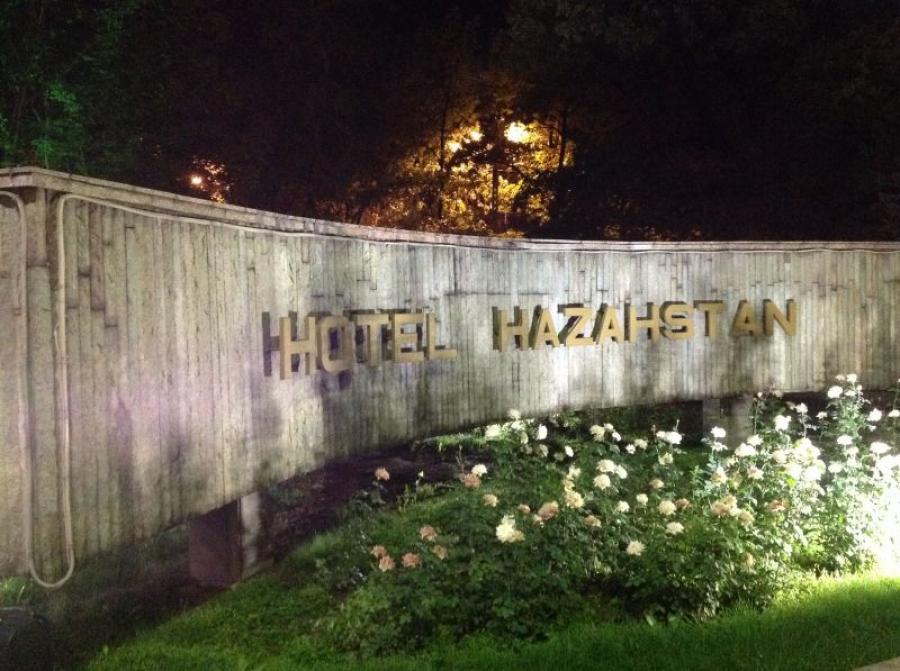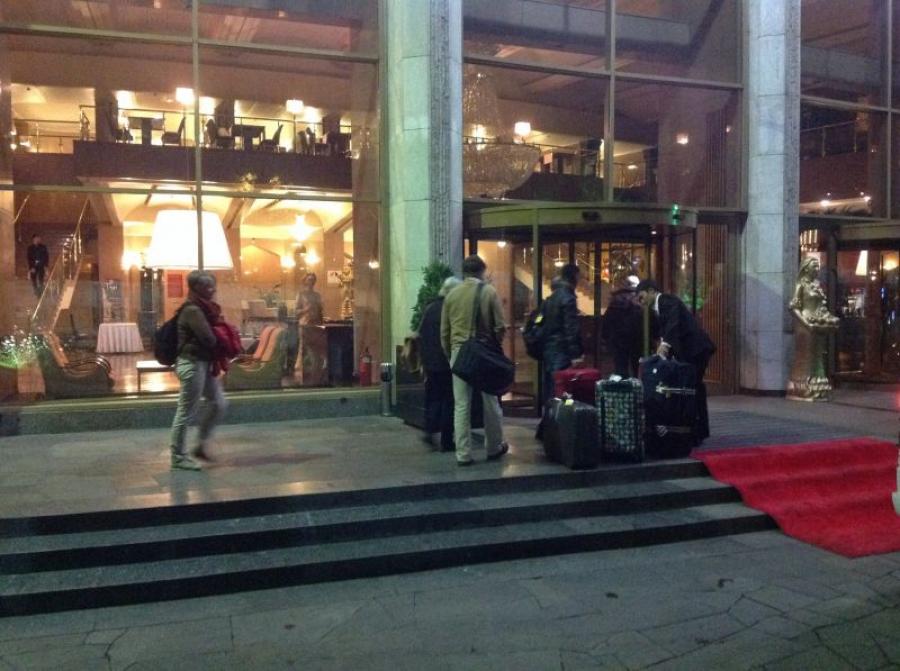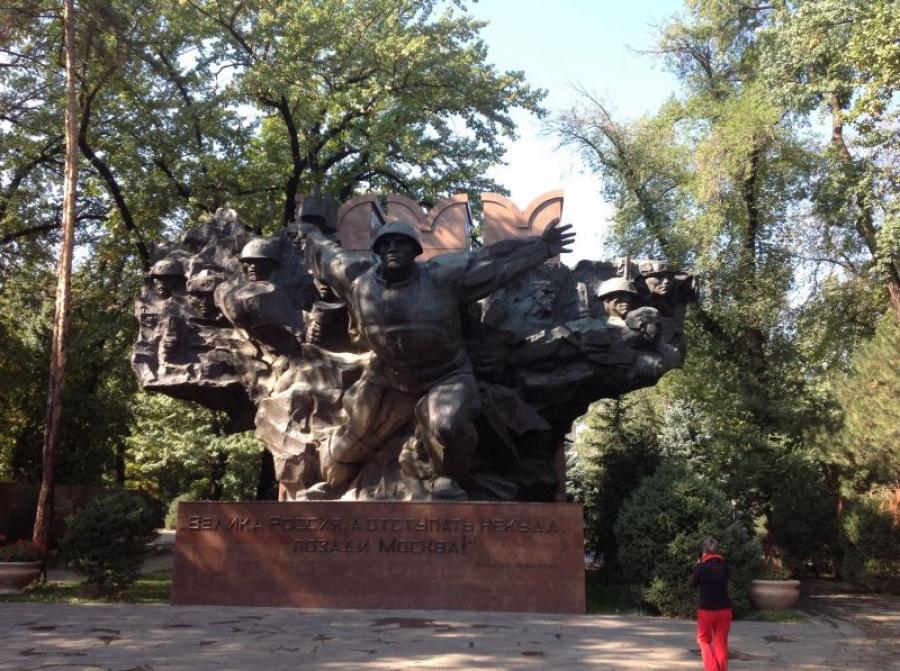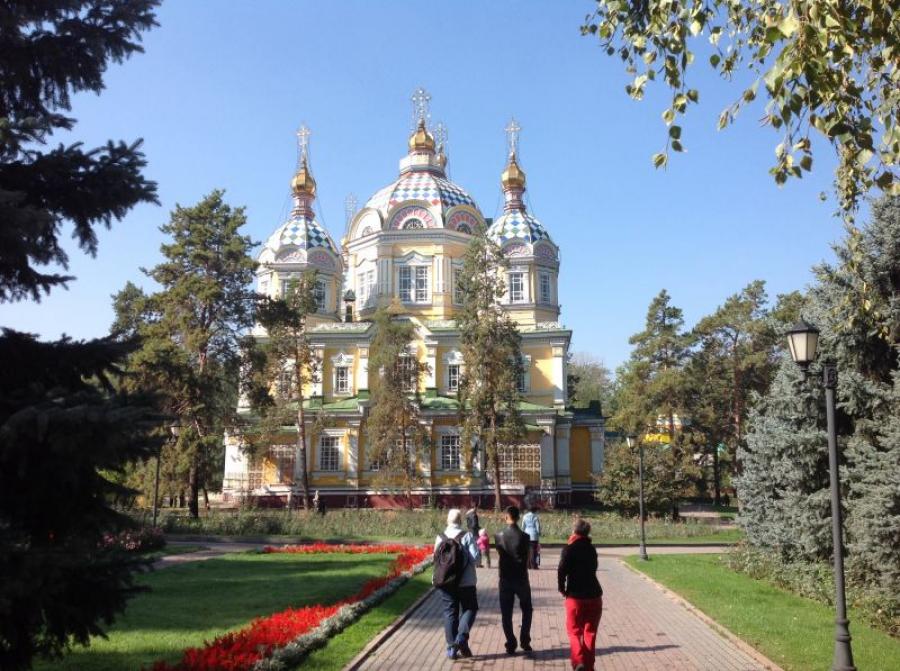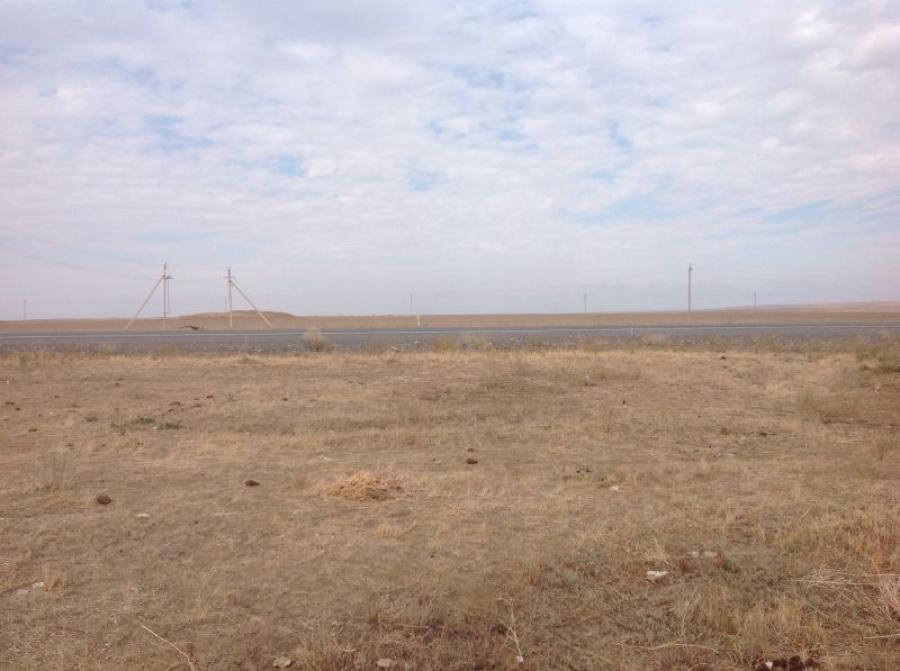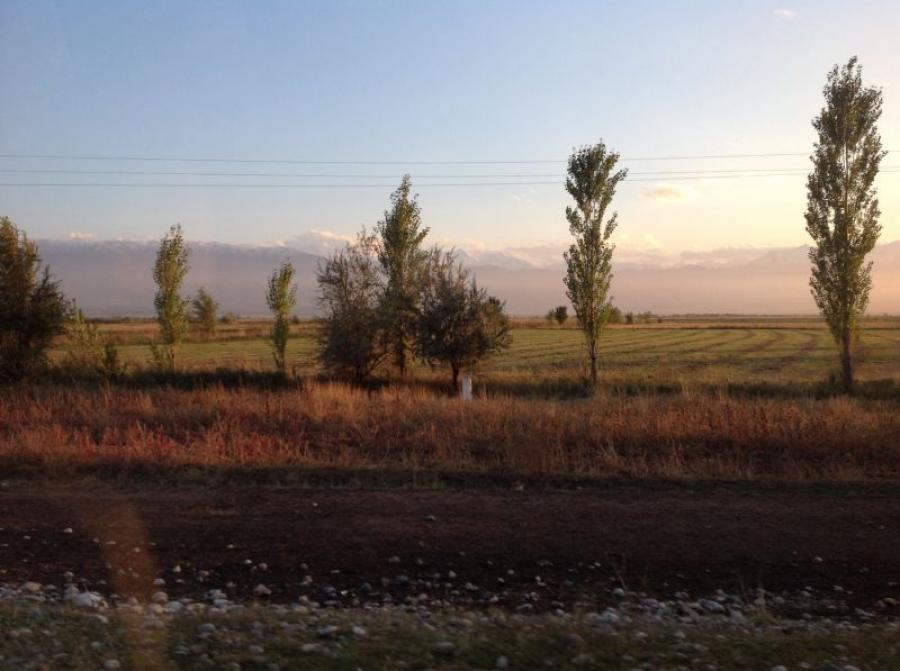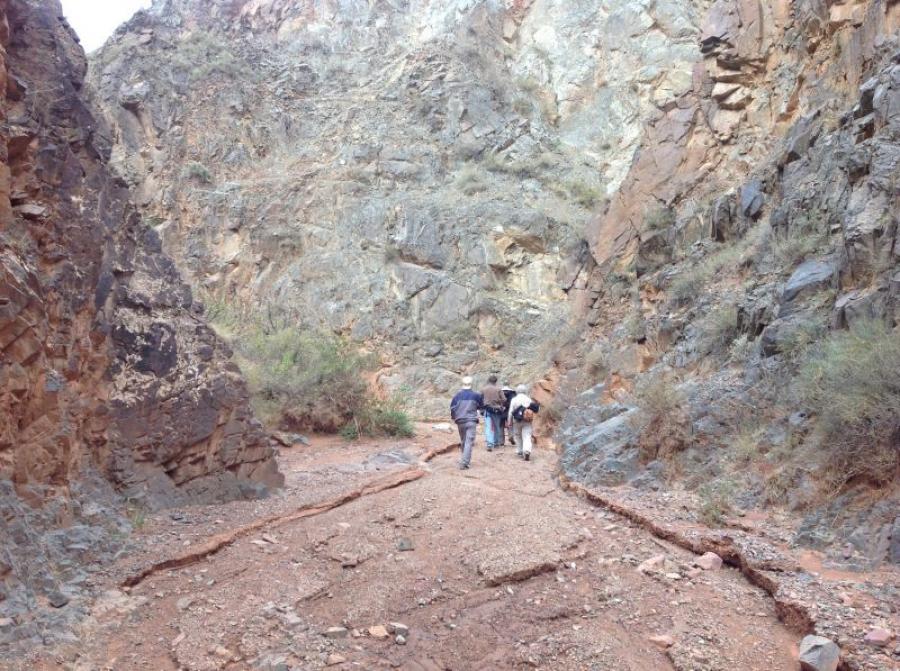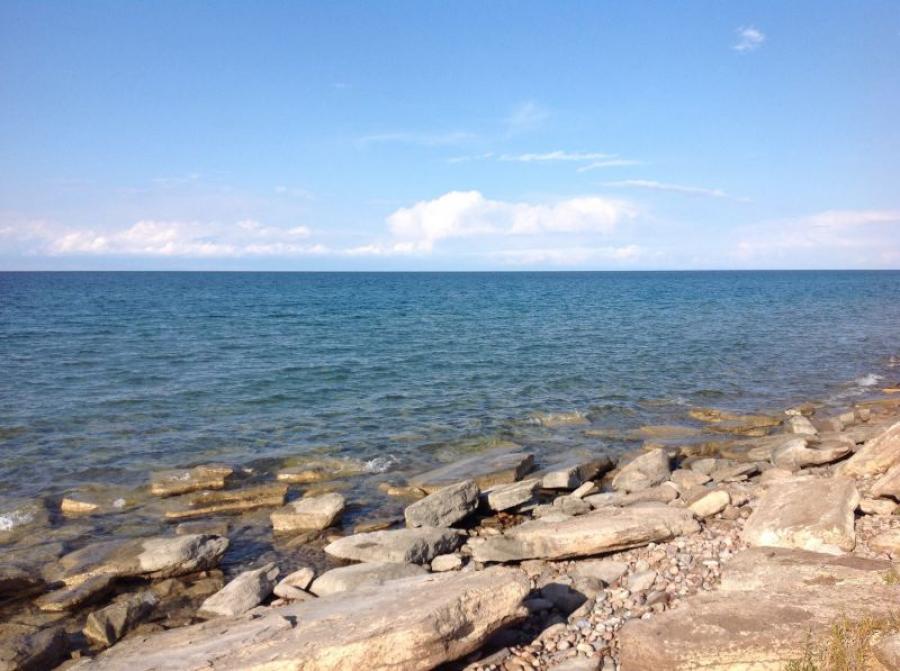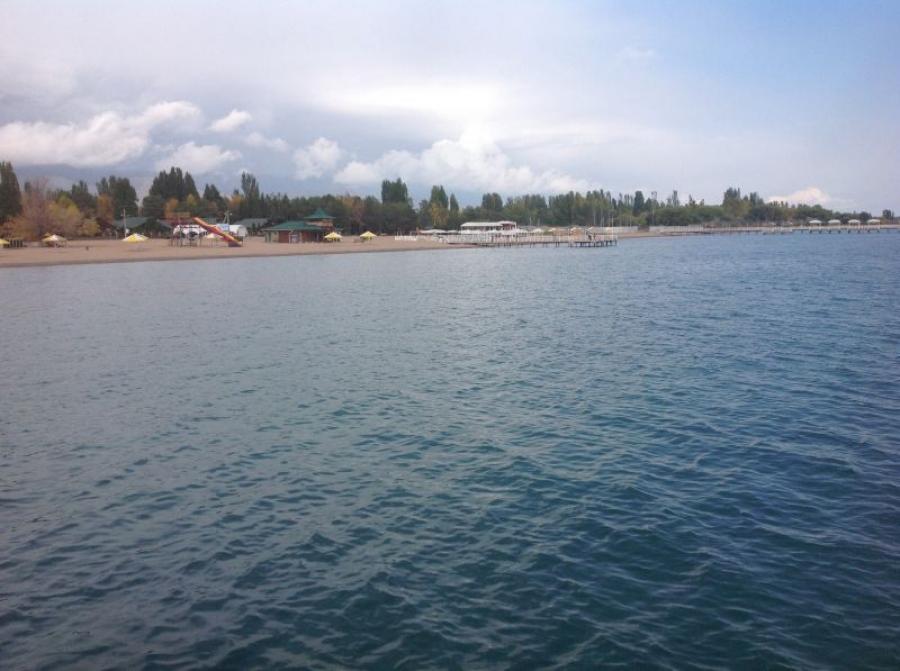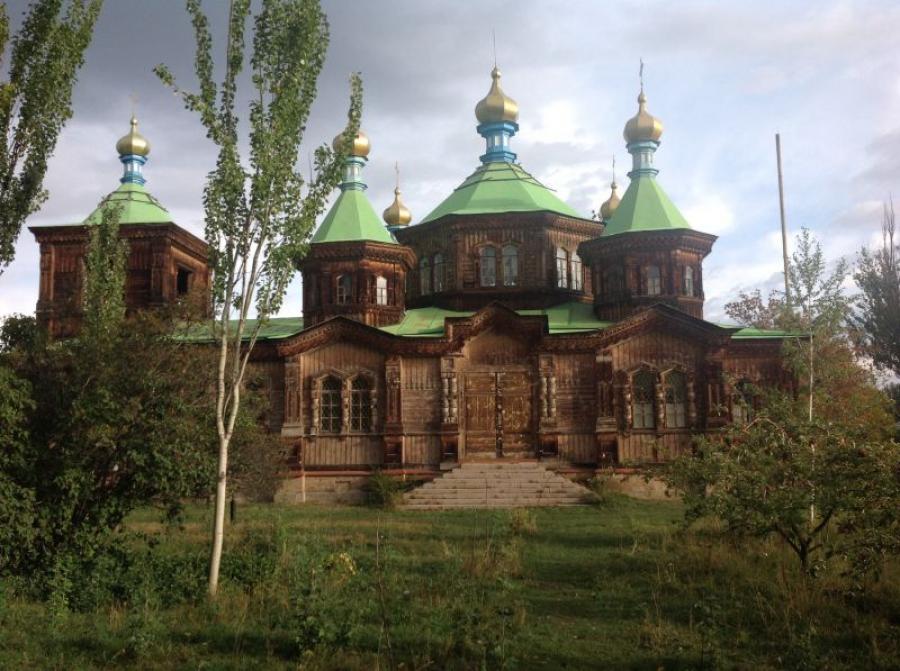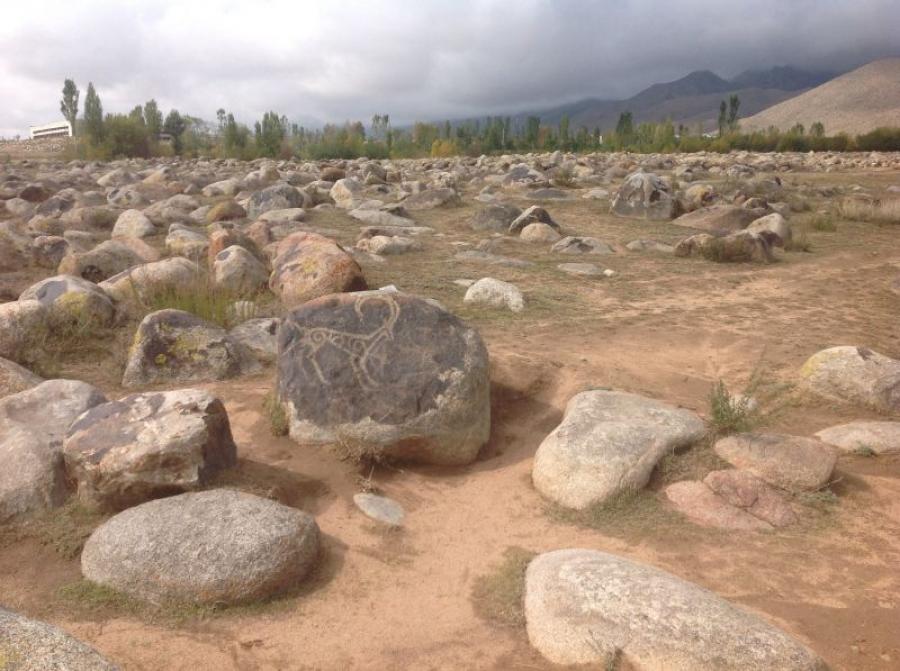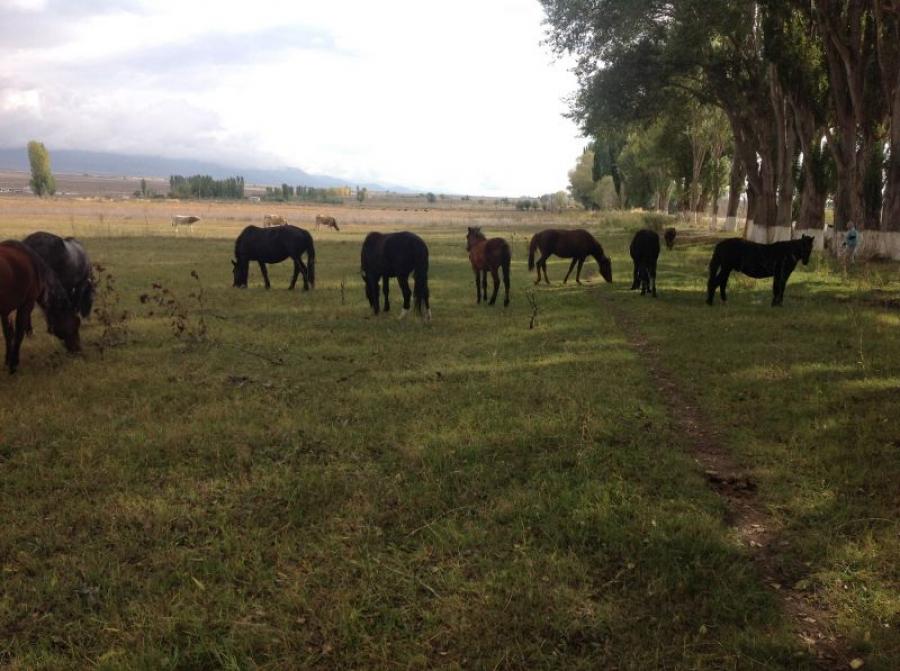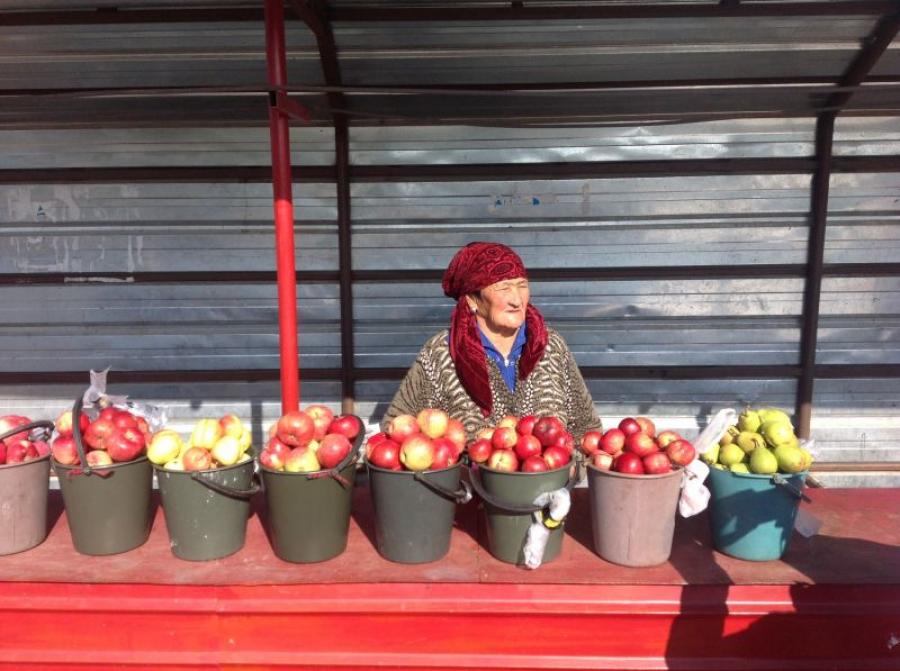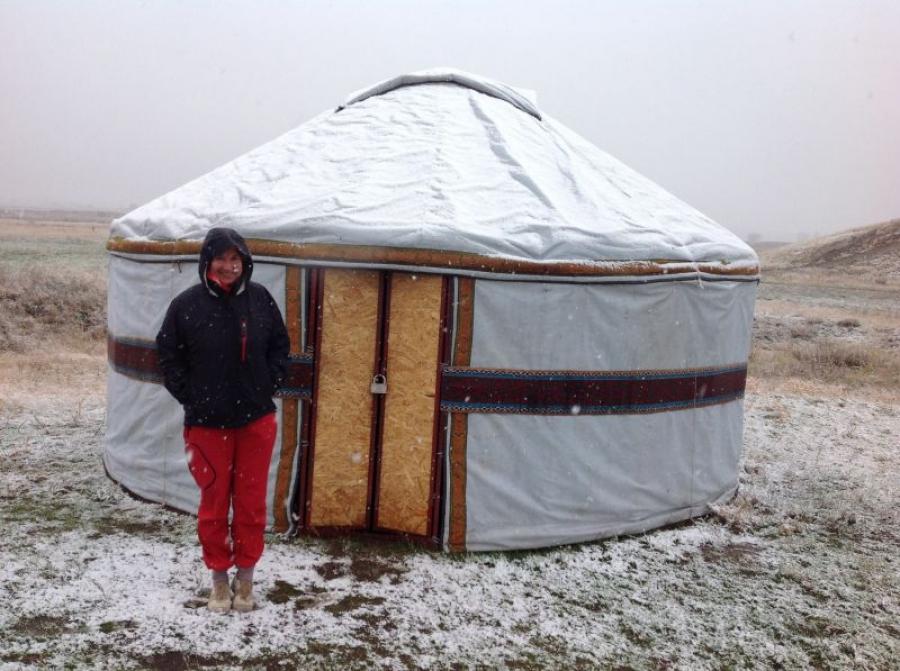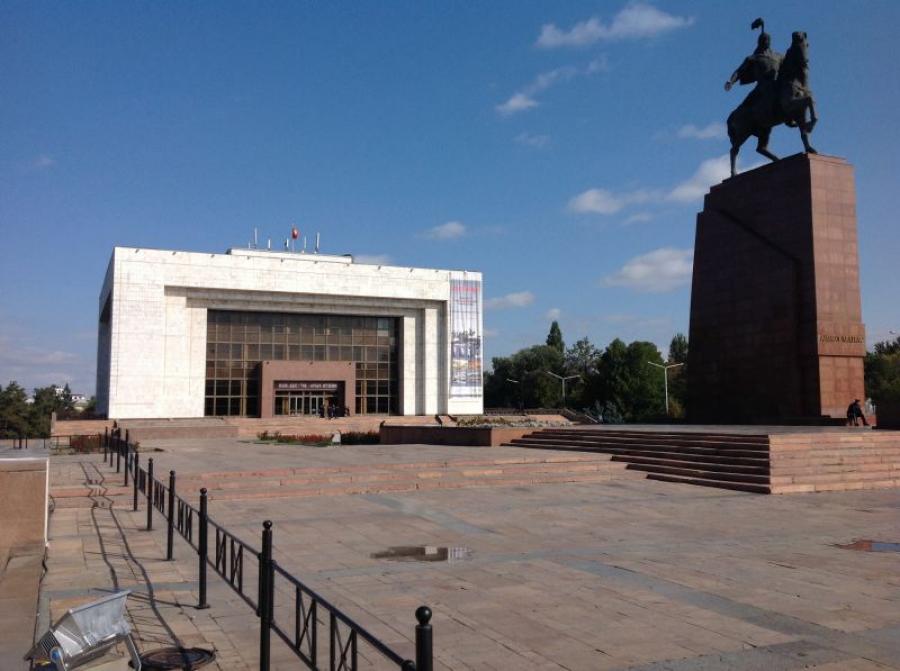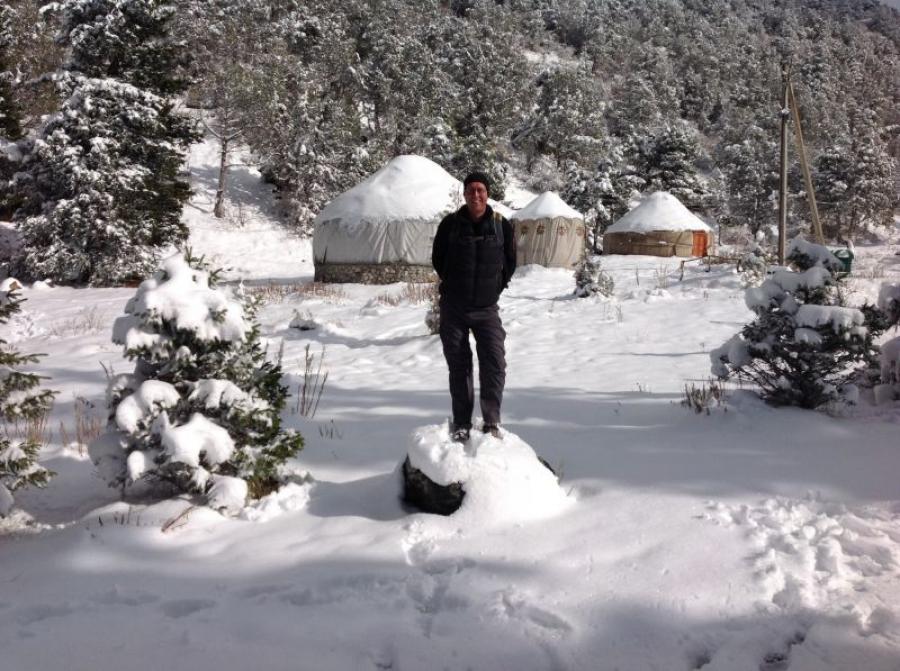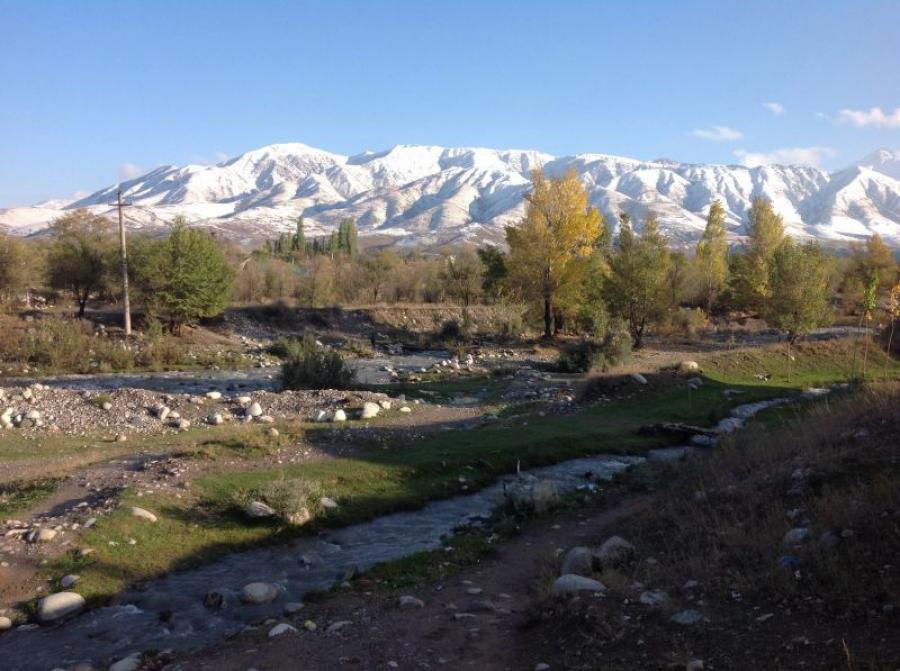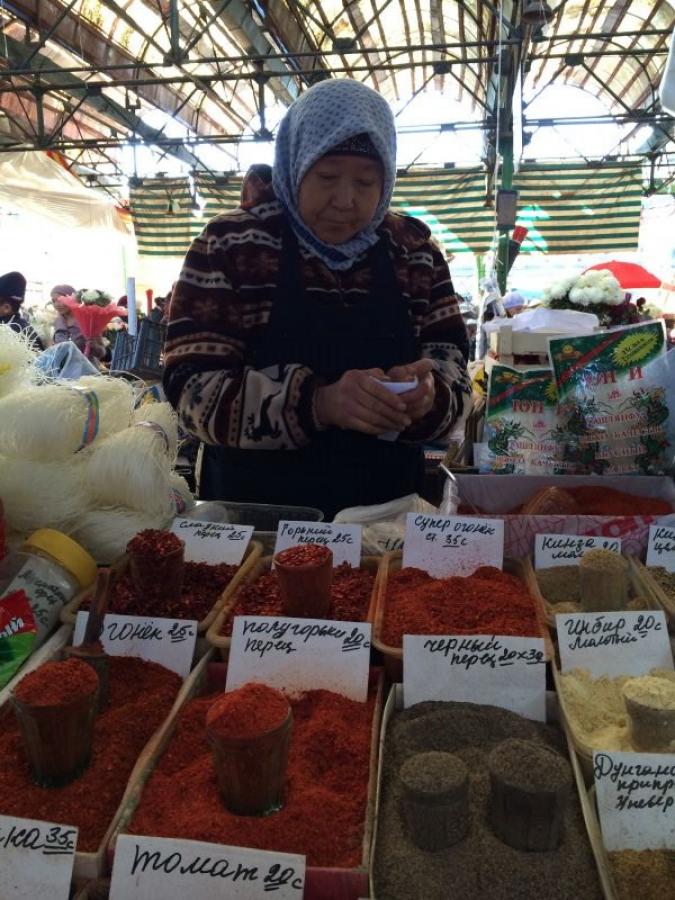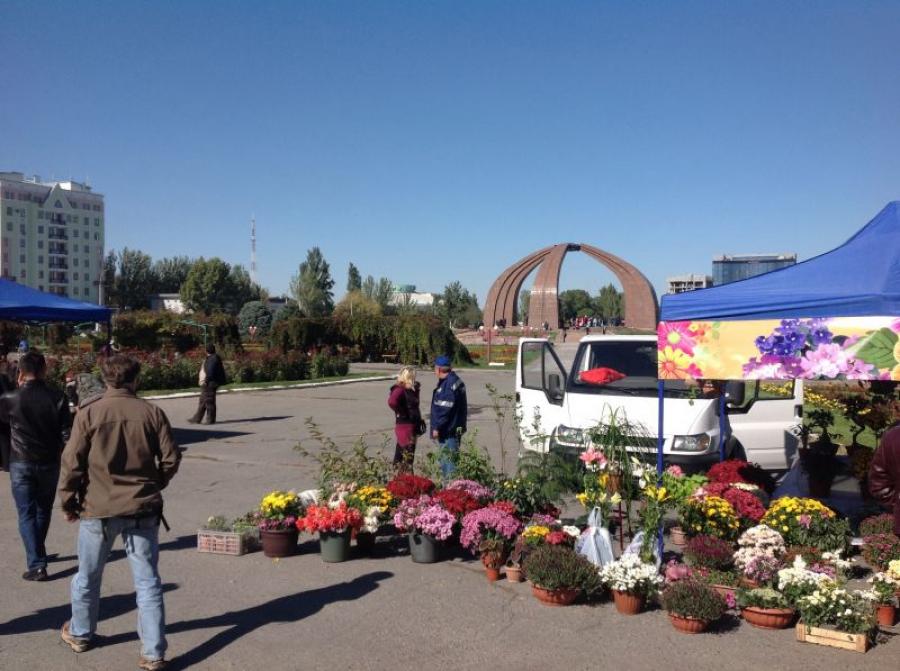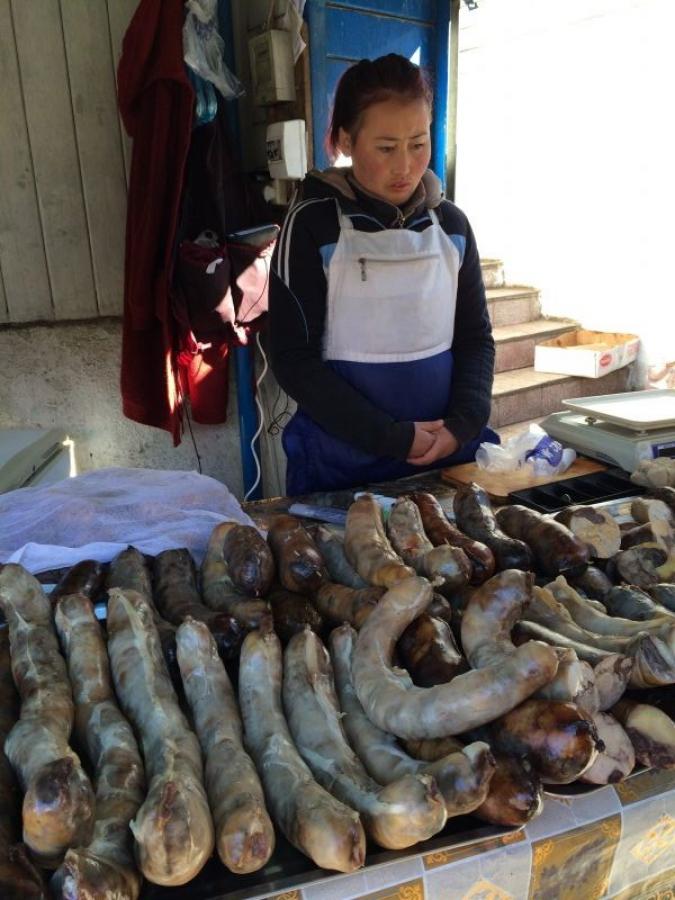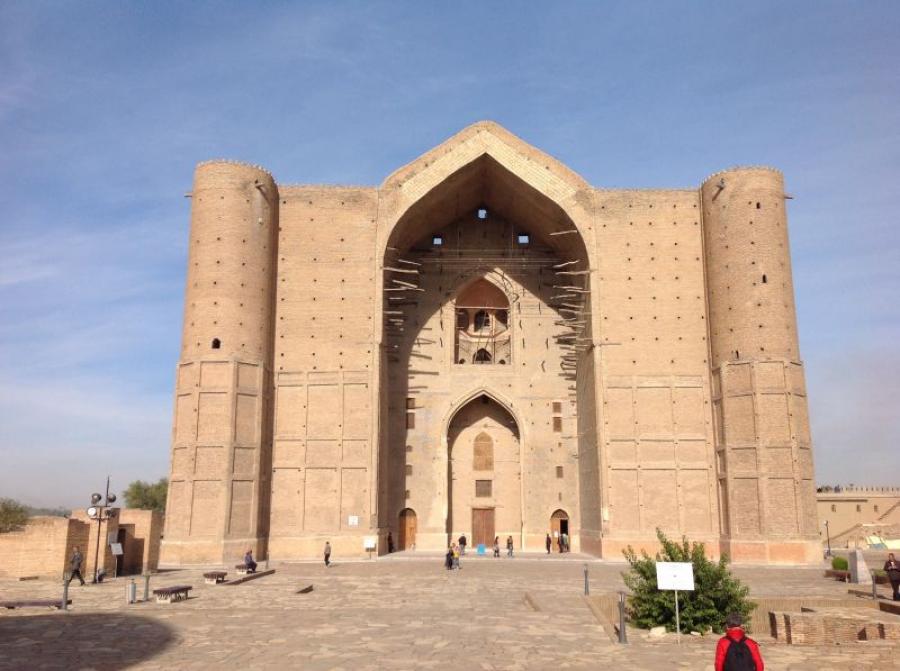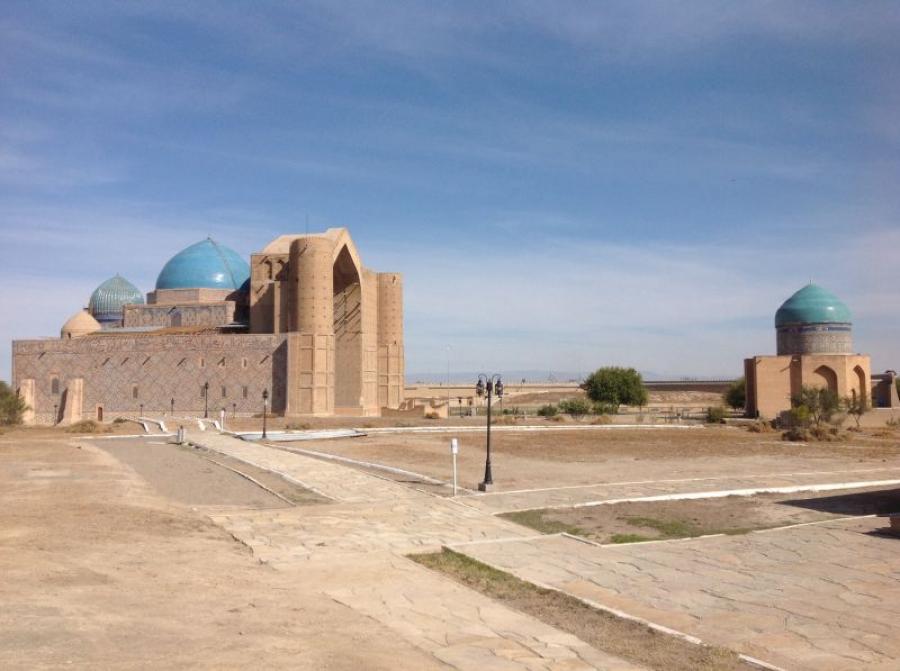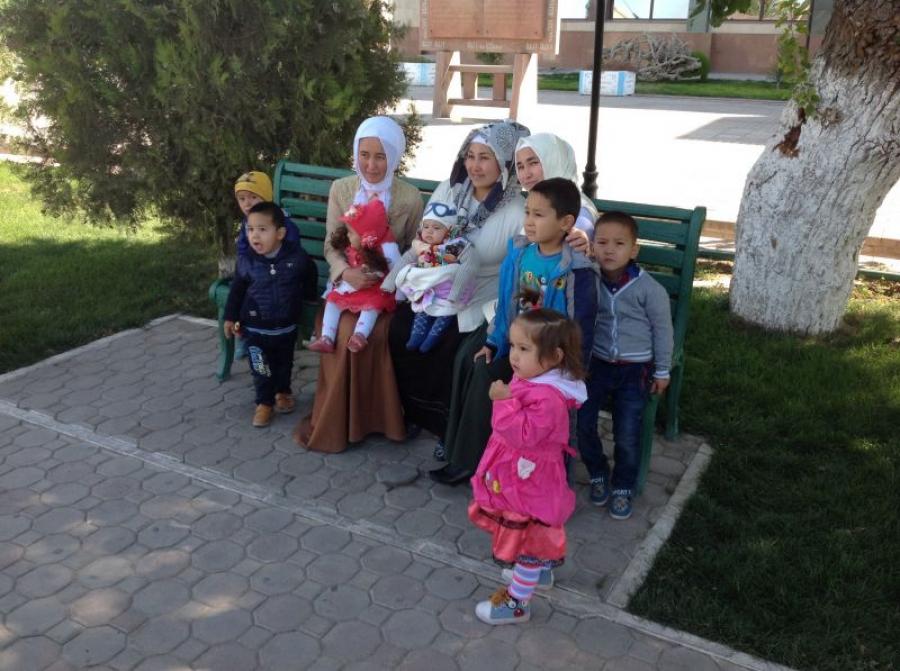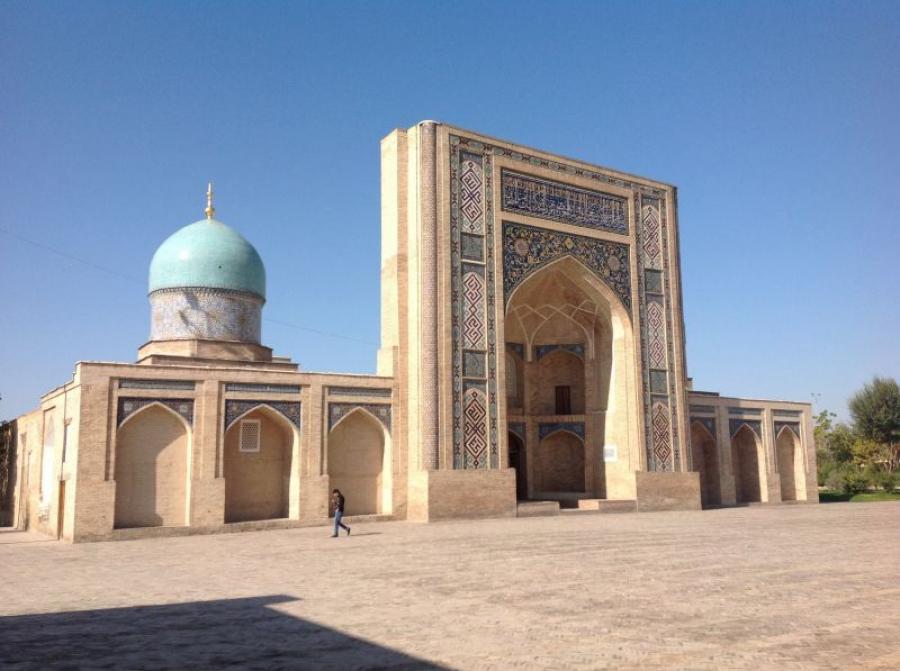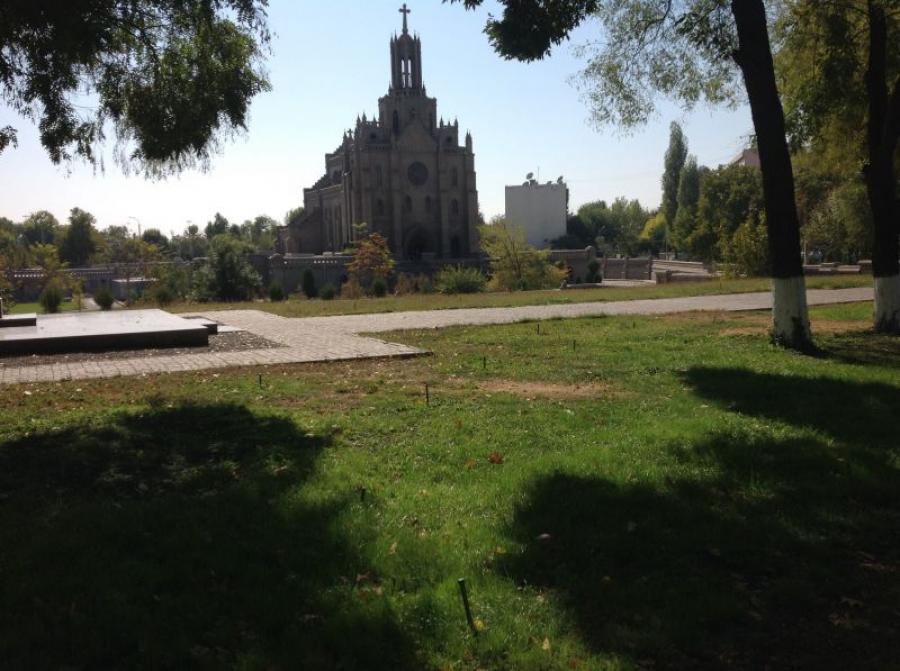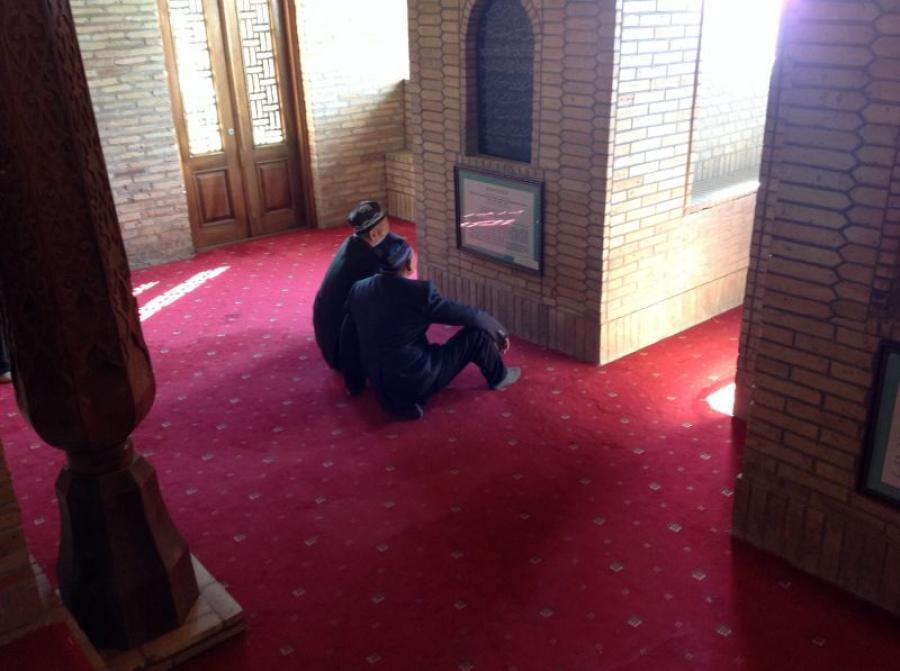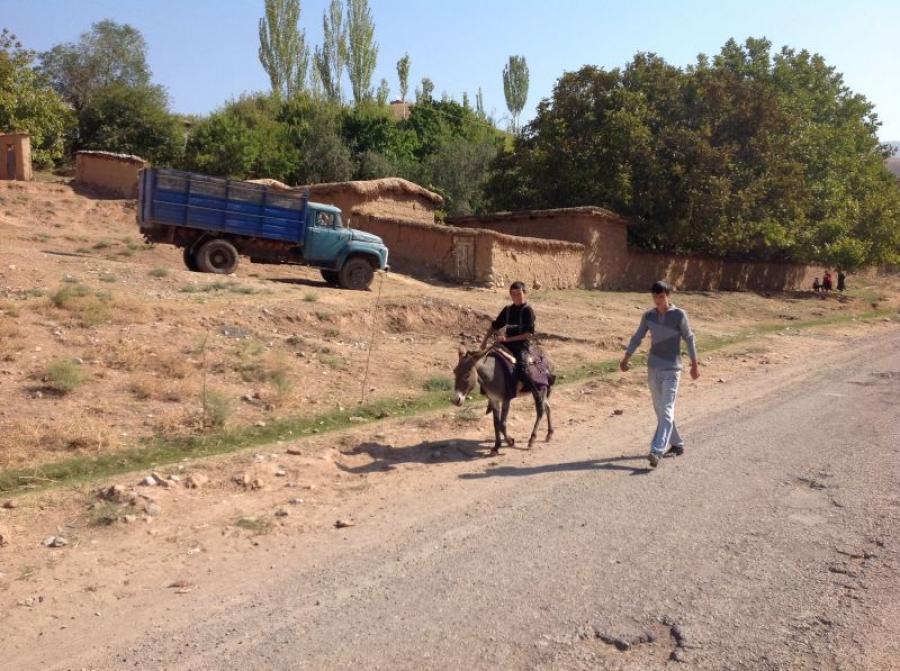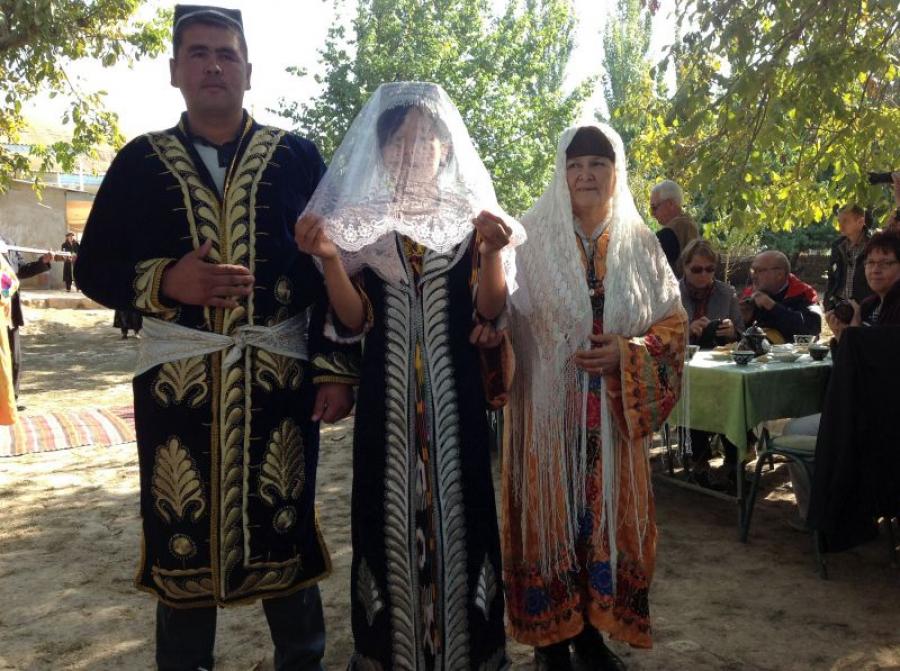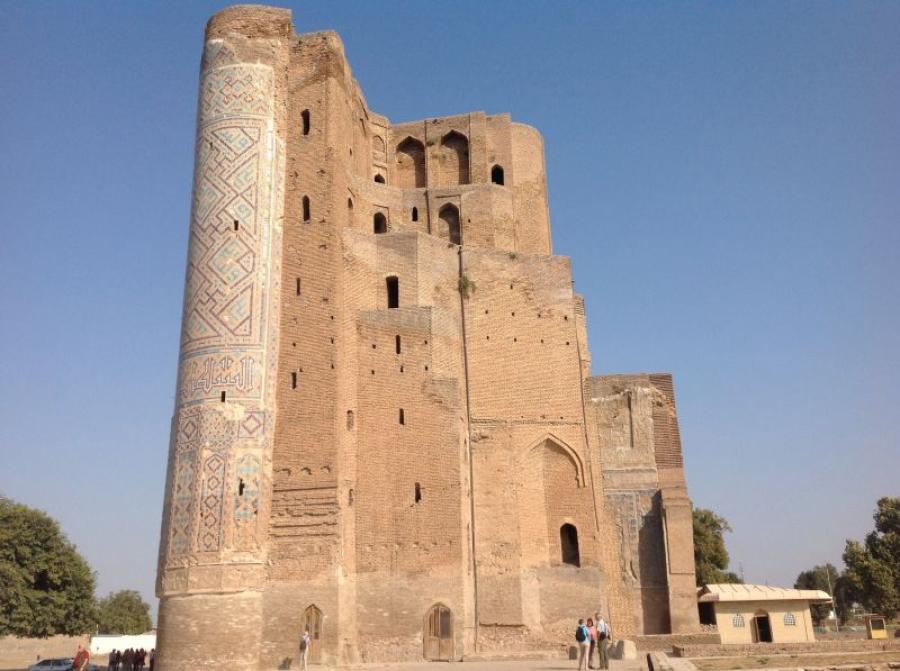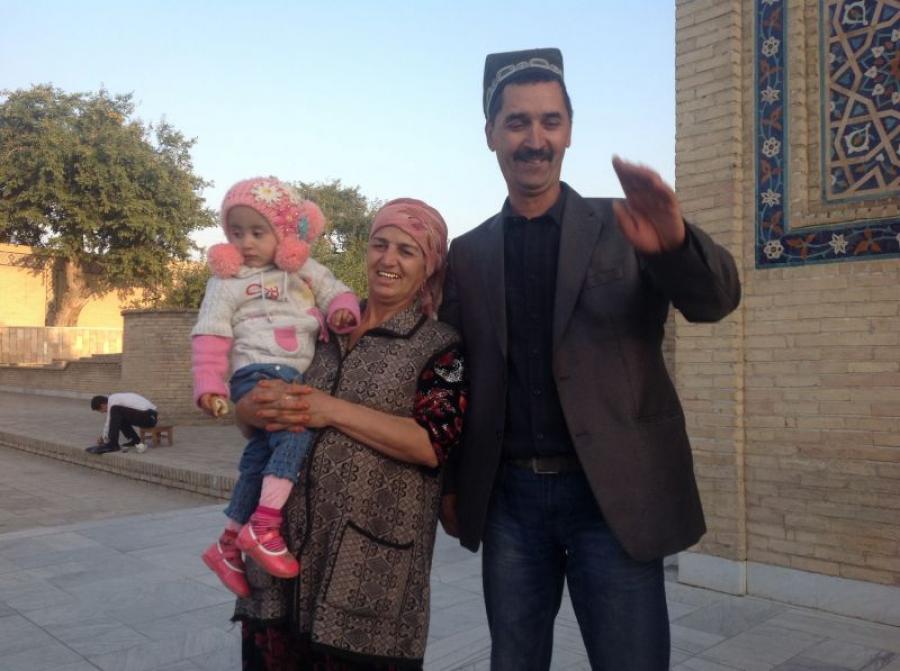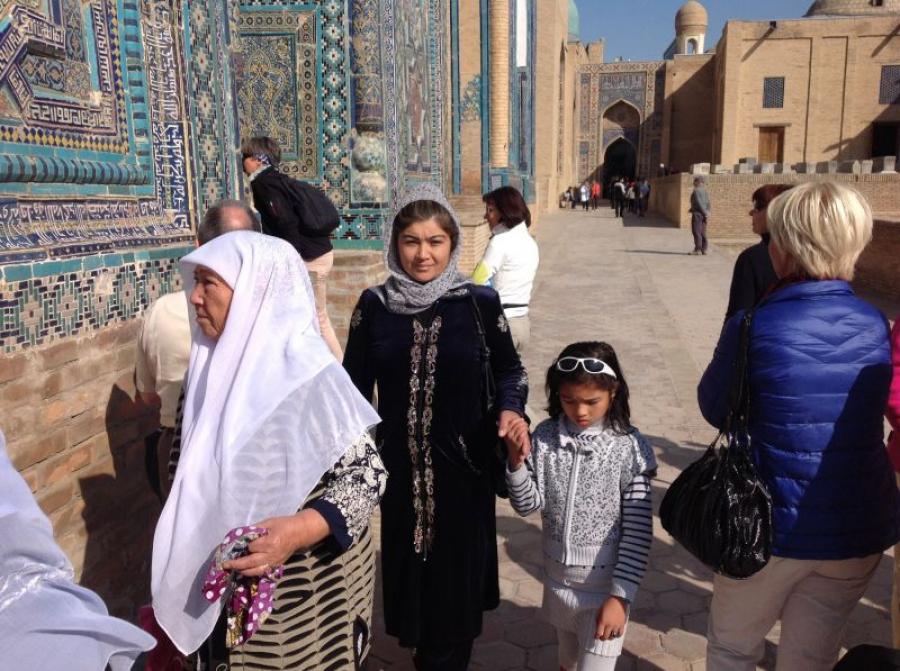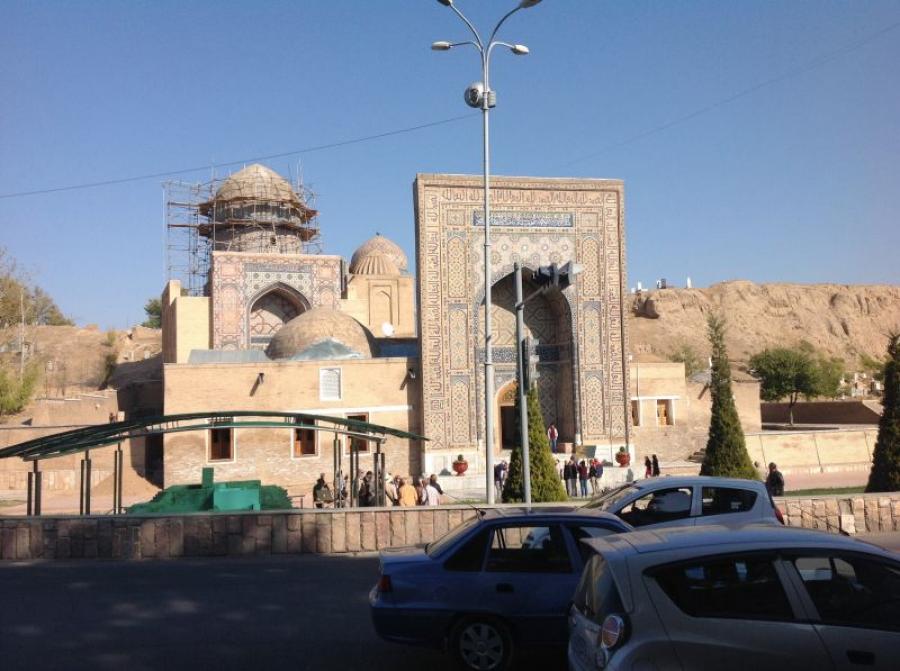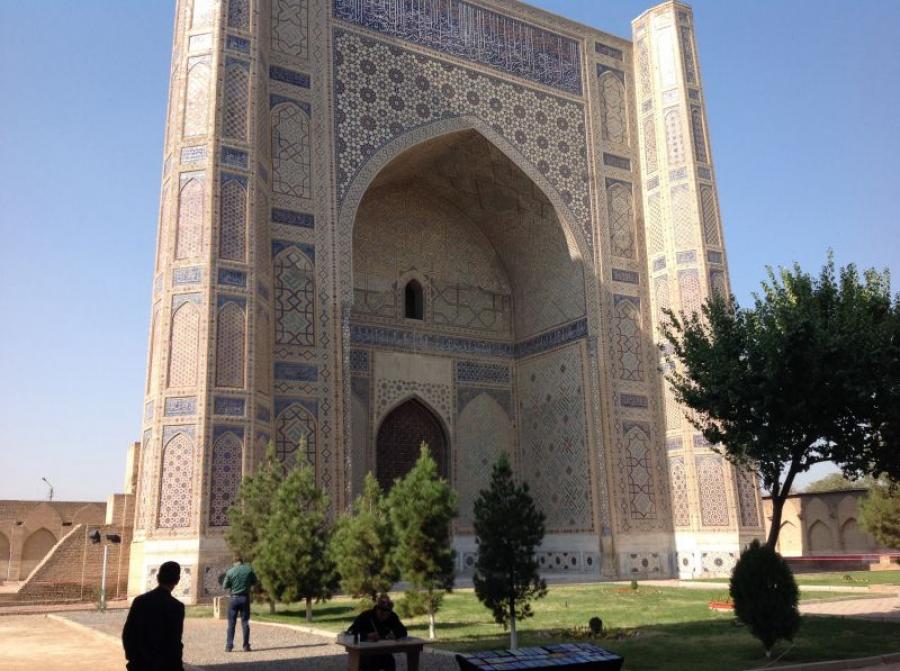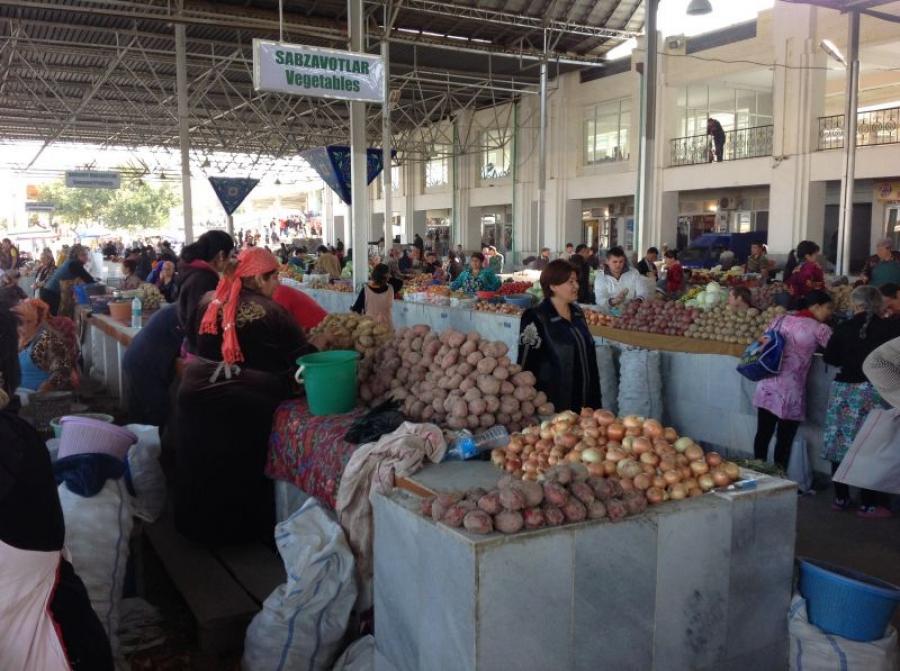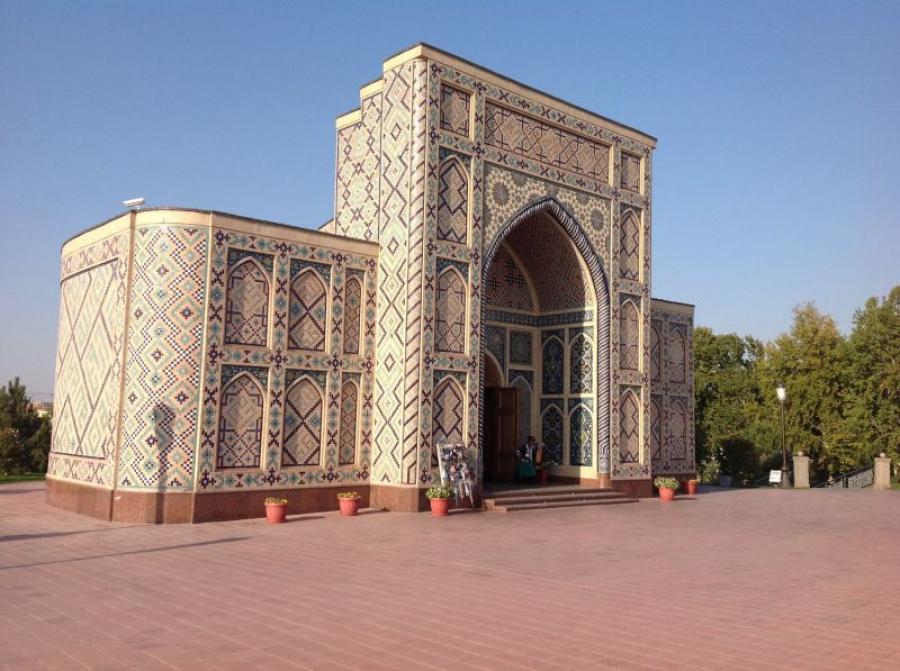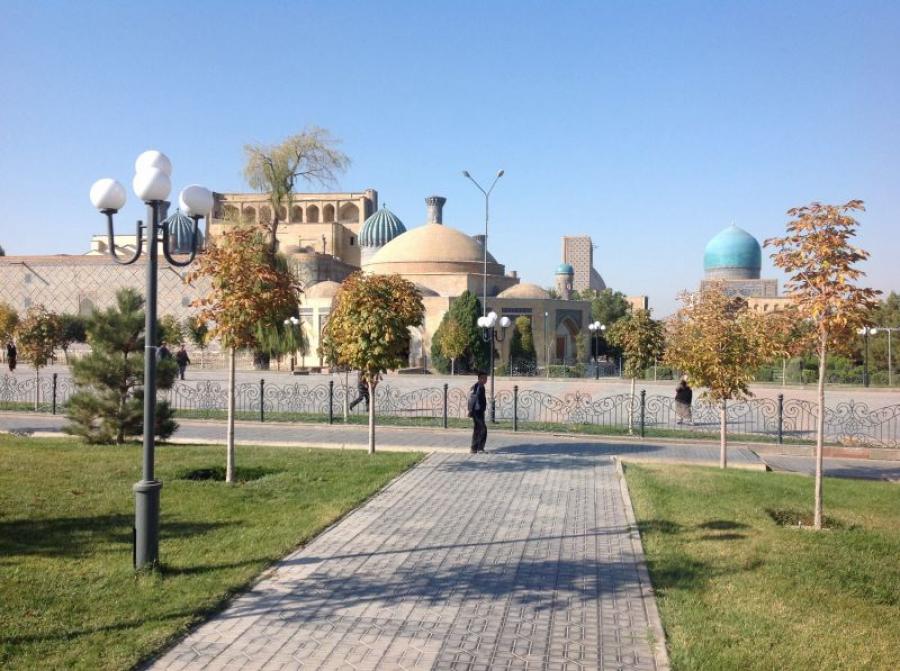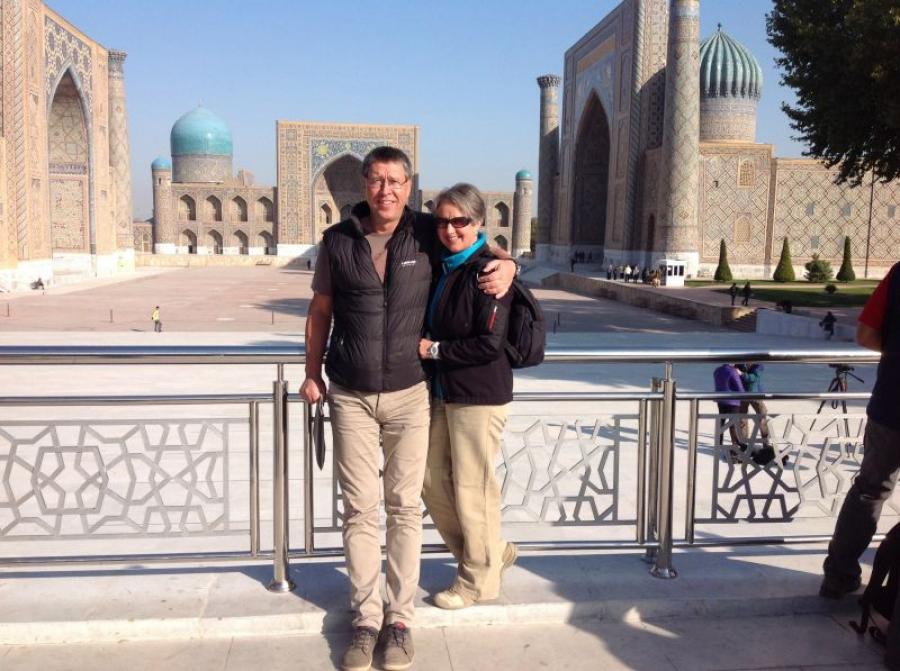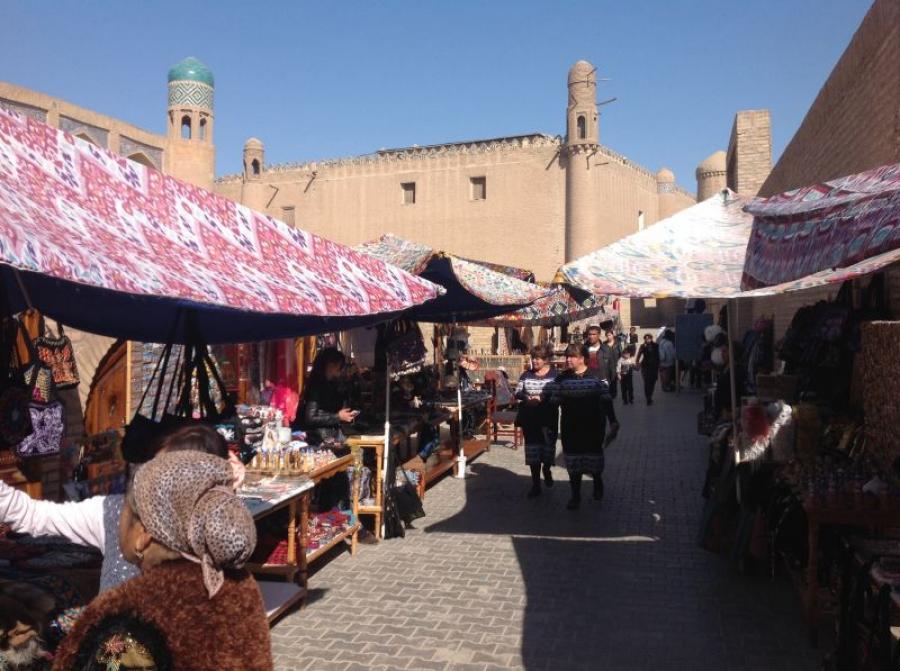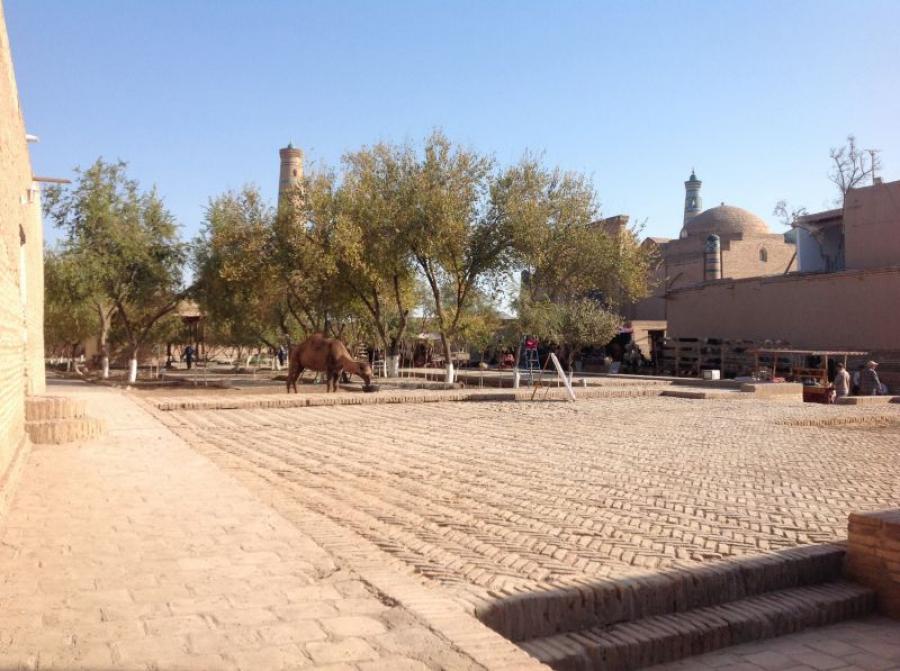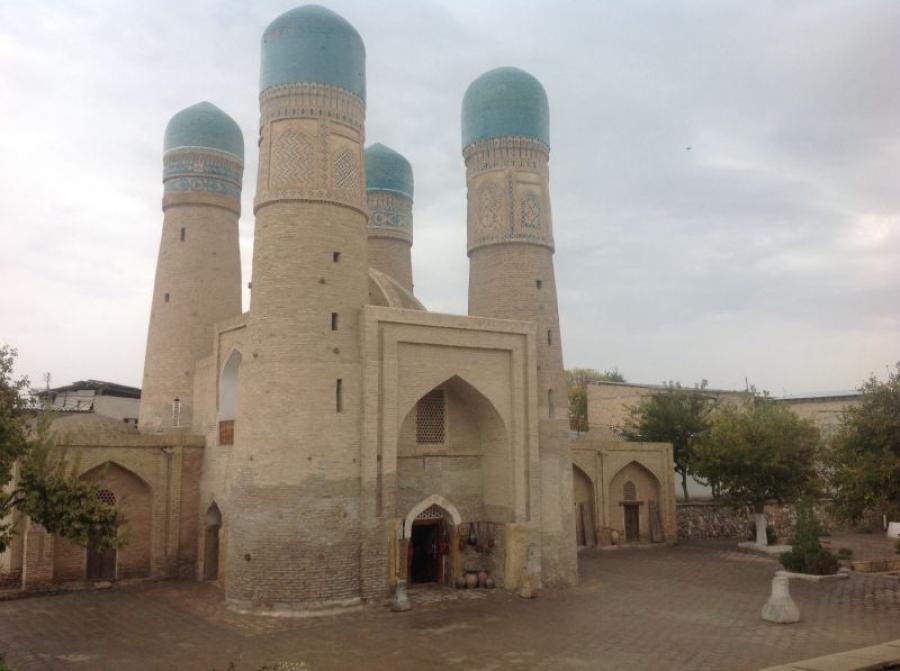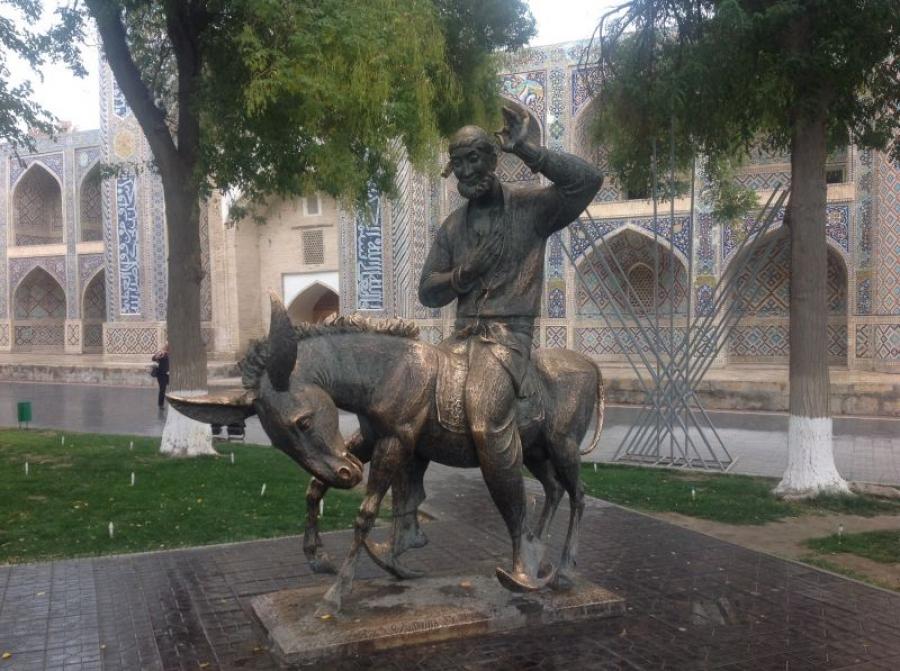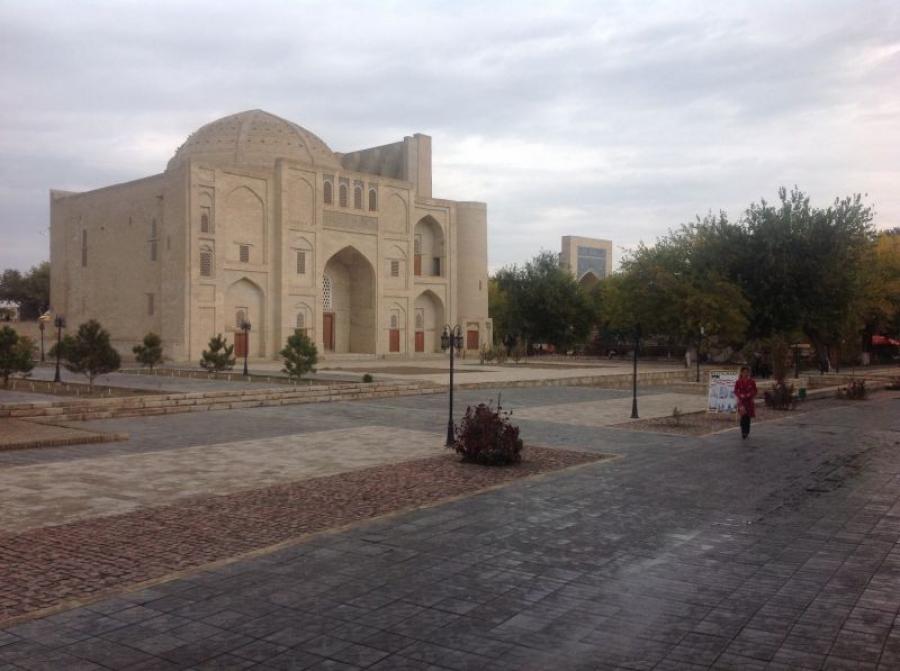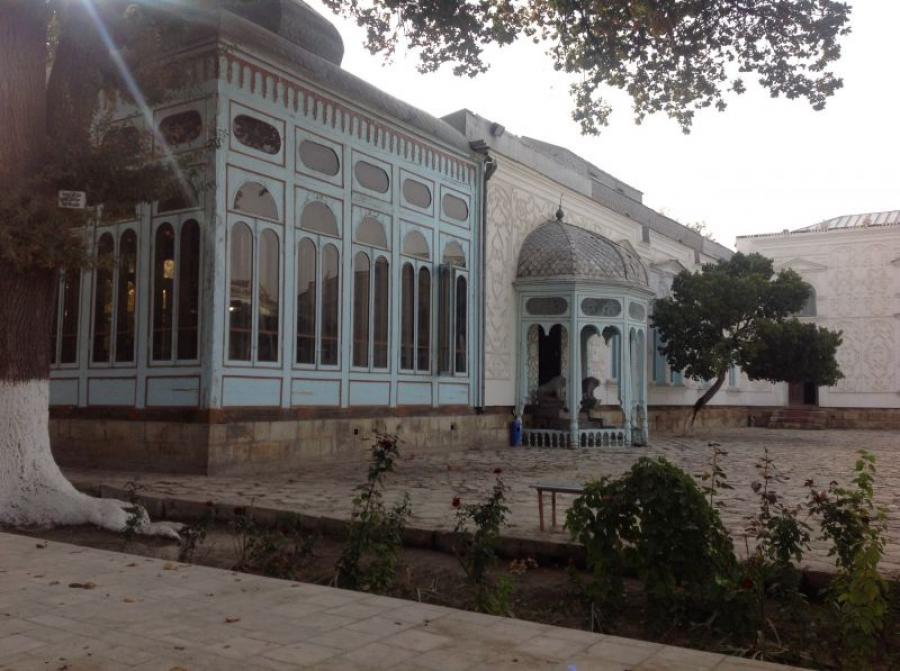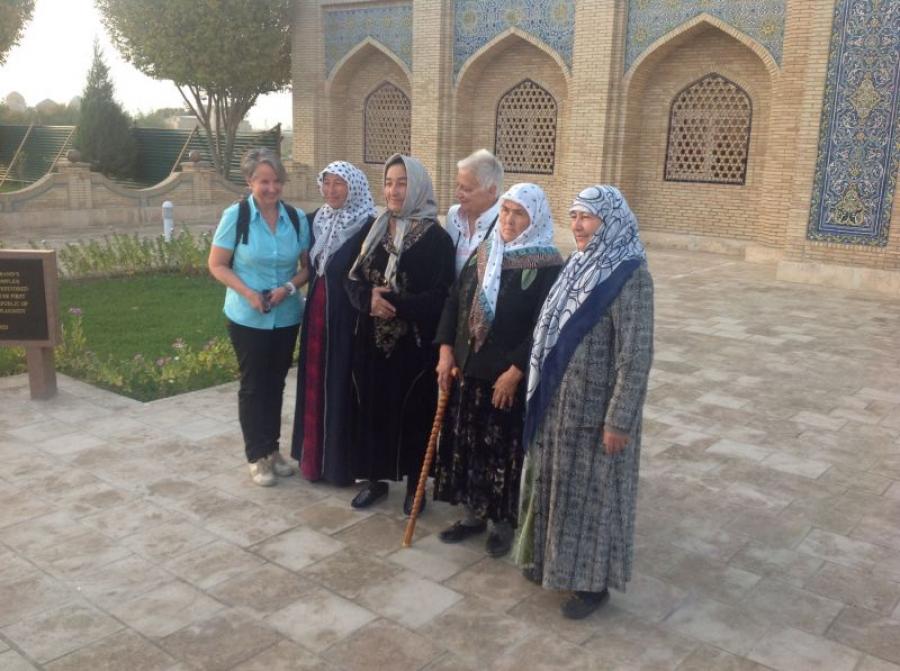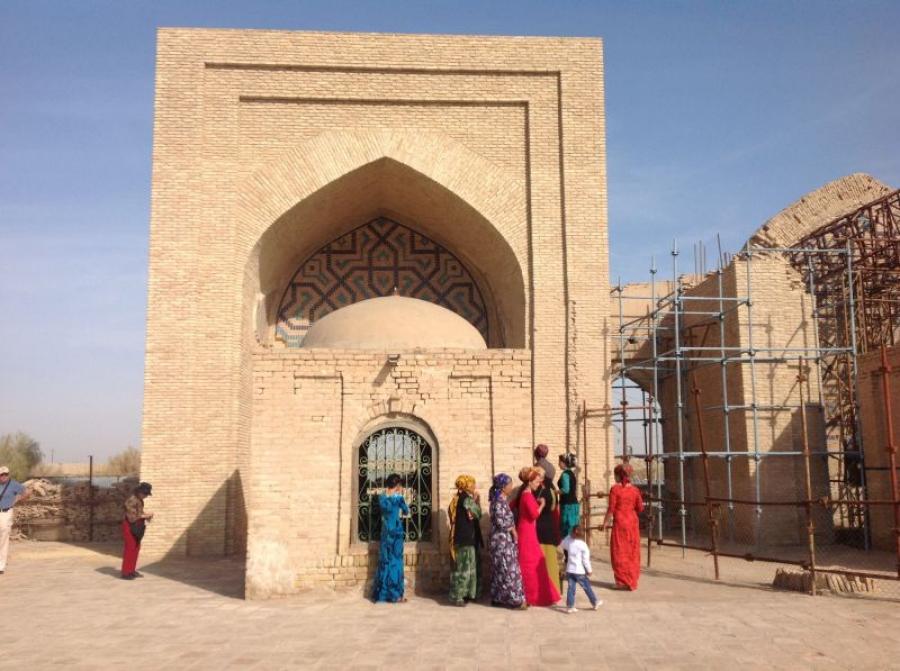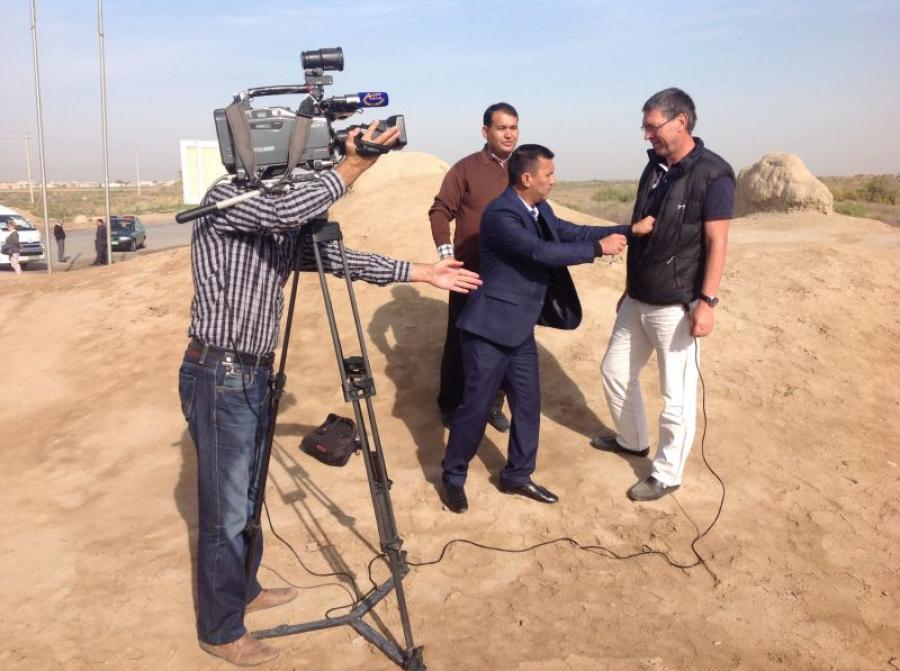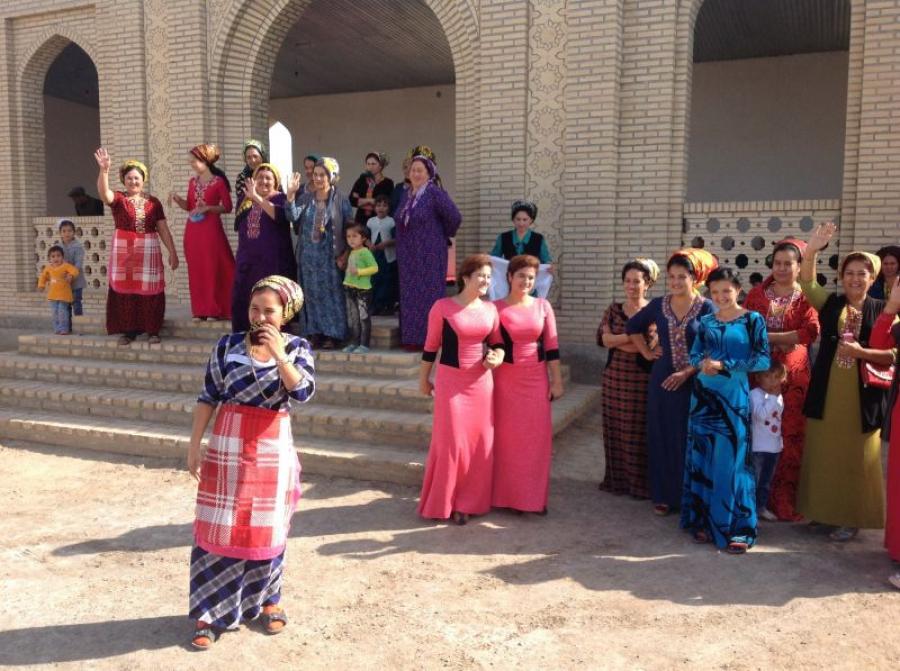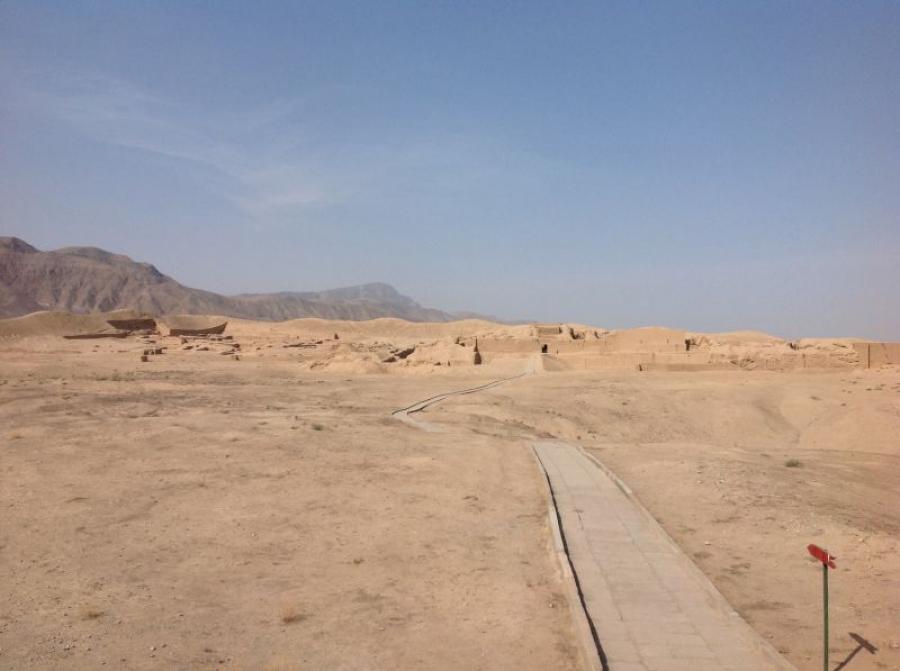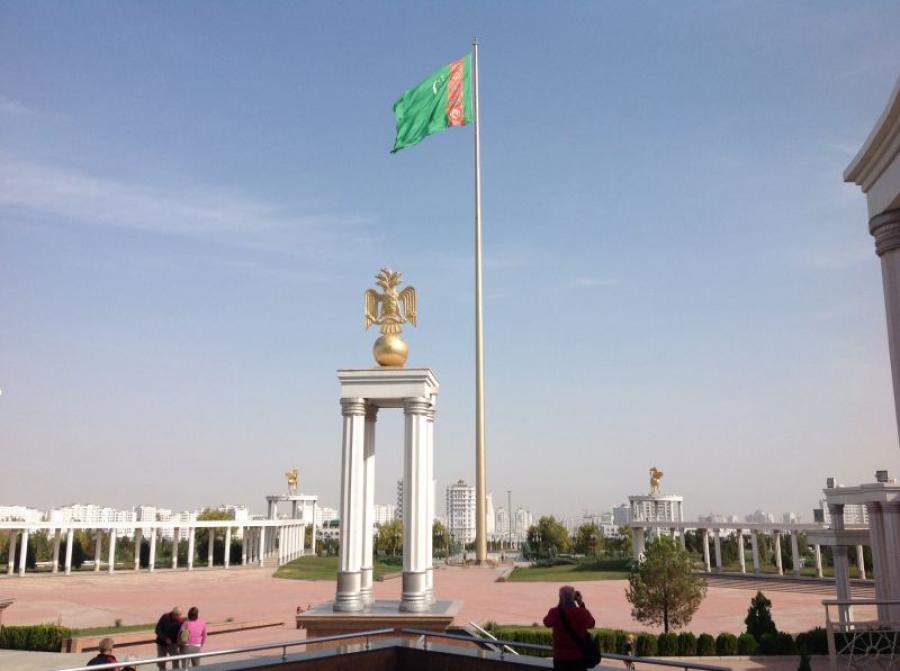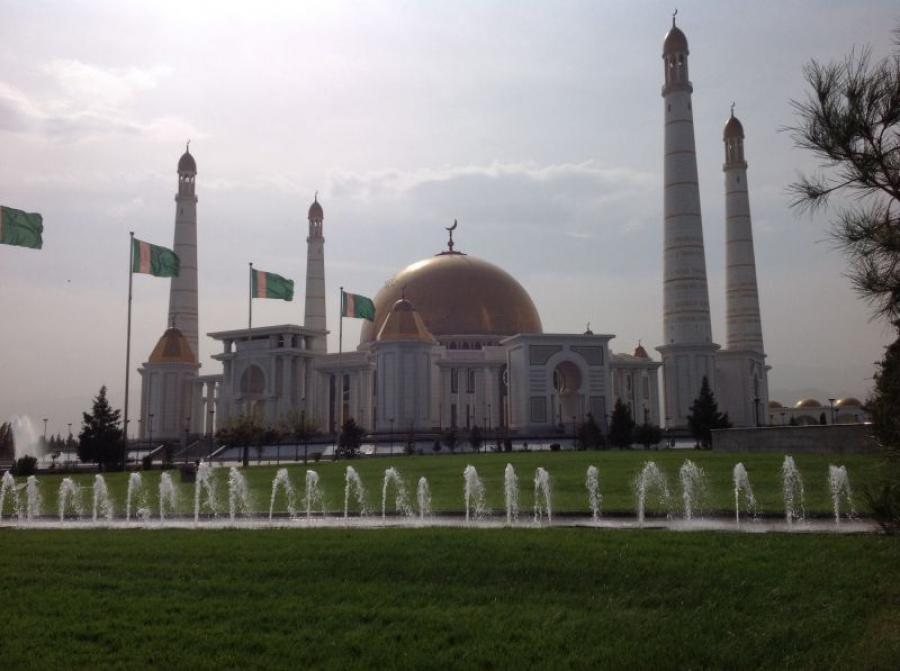Kyrgyzstan and the Silk Road
Asia far orient - Kazakhstan Turkmenistan - Kyrgyzstan Uzbekistan - Almaty in Kazakhstan
von 04.10.2014 bis 21.10.2014
Autor: Brigitte Wallner04.10.2014
BREAK TO ALMATY
Flight from Salzburg to Frankfurt and on to Almaty.
Today the departure to Kazakhstan starts at 08:00. The flight in Salzburg takes off on time at 10:45 and lands safely in Frankfurt. There is little time to change gates and with a 20-minute delay the plane takes off for Astana at 13:45.
After 5 hours and 20 minutes we land on time in Astana. In Astana we only stopped briefly for a stopover and after 50 minutes we flew on to our final destination. Arrival in Almaty was on time at 01:35 local time. Time difference from Central Europe + 4 hours.
At the airport in Almaty we completed the customs formalities and passport control and were reliably picked up. After a short drive to the city center, we were able to check into the Hotel Kazakhstan without any problems. Nothing now stood in the way of a pleasant night’s sleep.
05.10.2014
From the steppe to the mountains
In bright sunshine, the friendly guide Salamat picks us up at the hotel at 9:30 a.m. for a sightseeing tour of Almaty. The city was founded by the Russians in 1854, was the capital of Kazakhstan for many years and has 1.5 million inhabitants. Kazakhstan is home to 14 million people. The country consists of 80% steppe landscape. We experienced a small impression today during the drive to Kyrgyzstan. In 1991 the country became independent and Salamat shows us the monument on the square before we visit the Resurrection Cathedral. Many faithful Orthodox are present in the impressive church for the Sunday celebration. A visit to the Ykylas Museum, where the most important musical instruments of Central Asia are exhibited, completes the sightseeing. Especially much played was and is the Dombyra, a 2-sided instrument. On it you can play up to 3000 melodies. A few hours of driving through impressive scenery and customs checks bring us at 7 pm to a high valley, 1,600 m high, to our overnight stay today in Chong Kemin, rustic like a mountain hut. We feel almost at home, only the schnapps (vodka) tastes different.
Author: Brigitte Wallner
06.10.2014
Gorges and the Yssyk Kul
Invited for lunch by a Kyrgyz couple in their living room and dinner with a Uyghur family let us taste the delicacies of this country, and with full belly fall tired into our beds. The digestive liquor has been drunk twice today, but there were salads, soup, pasta with beef, freshly made dumplings with beef, still various desserts to taste. But before that we marched 2.5 h in the morning in a canyon through a dry riverbed to be rewarded with a view worth seeing with a view of the Konorchek canyon in a rustic moonscape. On the way to Karakol, our overnight place today, we drive along the idyllically situated Issykkul Lake. The body of water is 180 km long, 60 km wide and 700 meters deep. It is located at 1600 m and is the second largest mountain lake after Lake Titicaca. The passing landscape lets us come to rest. There is no hustle and bustle here. Fields with grazing horses, cows and sheep, hills in the background like in a painted picture and further back the snow-covered mountains make the drive along the southern shore of the lake a pleasure. Karakol is the provincial capital on the lake, the largest with 60,000 inhabitants. It was founded by the Russians in 1969 as a military town. Today the people live mainly from agriculture and tourism. Conclusion of the day: body and soul have been filled and fulfilled today.
Author: Brigitte Wallner
07.10.2014
North side with view of the Tien Shan
Tuesday, 7.10.
The silence of the night lets us sleep very well and strengthened after a breakfast we start the day with a city tour of Karakol. The Russians built the Orthodox Trinity Church in wood with many carvings.In 1880 it was destroyed by an earthquake and rebuilt under Tsar Nicholas II in 1896 and still exists in this form. During the Soviet period religious practice was forbidden and the church was used as a sports hall. Afterwards we visit a mosque that resembles a Buddhist temple. The Dungans, Chinese Muslims, arrived in the 19th century. From China and built this place of worship with Chinese craftsmen in 1907. The Dungans speak Chinese but have Muslim names. Przewalski is an important name in the history of Kyrgyzstan. In the museum dedicated to this Russian-born man, we learn about his geological and exploratory skills, or his 5 major expeditions that took him as far as Tibet, He was also awarded the Humboldt Prize, among others. Be. Monument stands in Karakol and the city was called Przewalski until 1990. We continue along the beautiful lake on the north side to Cholpon-Ata, where one of the largest stone fields with petroglyphs is located. Our hotel is a resort right on the lake for tonight. We are the only guests, sit on the empty beach in the afternoon and enjoy the sun rays that occasionally flash through the cloud fields, Heimo still dares to jump into the water; felt 18 degrees.
Author: Brigitte Wallner
08.10.2014
Kyrgyzstan in scnee
The night before, after dinner, all six of us had a drink of water in our room while sitting comfortably together. After a good night’s sleep, we are awakened by the gentle rays of the sun. We take a farewell photo of the calm lake, and breathe in the autumnal morning atmosphere. The journey continues to Bishkek, the capital of Kyrgyzstan. During the ride we see horses, sheep and cows, now and then a Kyrgyz farmer proudly sitting on his horse with the typical white felt hat. Women with their colorful headscarves sell the freshly picked apples on the street. They taste delicious. The landscape is idyllic and radiates tranquility. The weather changes quickly; strong winds come up and we drive right into a front that brings rain and last but not least snow. The snowfall accompanies us until Bishkek and settles on the meadows and the whole area as a white blanket. On the way we will visit an open-air museum, which displays evidence from the Turkic period and stone sculptures of the nomads. We are freezing in our light sneakers and jackets, but still have our fun, especially since our bus driver has heated up well. On the way we stop in Rotfront, a village founded by German settlers at the end of the 19th century. founded village. The community leader shows us the community and prayer room built in wood, tells us about his village, where 10 families of German origin still live. We didn’t think that we would see the first snowfall for the coming winter in Kyrgyzstan.
Author: Brigitte Wallner
09.10.2014
Bishkek the capital of Kyrgyzstan
9.10. The beauty of Kyrgyzstan and a camel in the snow.
Salamat, our guide, picks us up in bright sunshine and zero degrees for the city tour. Thank God we have ski underwear in our luggage, it warms under the thin trekking pants and jacket.
We walk past the Opera House, built by the Russians, on to Oak Park, which has many sculptures by individual artists from Russia and Kyrgyzstan. Bishkek was founded by the Russians in 1878, is the capital and has one million inhabitants. Our way leads past the american. University, continue to the Parliament and the monument of Manas the Great. This was a mystical person, shaped the history of Kyrgyzstan, According to tales, the great Manas united the 40 tribes. For many centuries the stories were passed on orally by the nomads. In the 19th century. the work was written down in poem form. It contains 500,000 stanzas and tells the 1000-year history of Kyrgyzstan. In schools, Manas is in the curriculum in history.
After lunch we drive to the Ala Archa National Park and are amazed by the first amount of snow. During the drive we discover a lonely camel standing a bit lost in the snow. Farmers drive the animals out of the snow on their elegant horses. They have been surprised by the sudden cold. The panorama is unique and makes you want to take pictures. During a walk we are happy about the white, although our thin sneakers give us wet feet. With a sip of water, however, we quickly warm up again in the bus.
Tomorrow we will visit the market in Bishkek and then leave Kyrgyzstan, the country in the mountains that we like so much, by local train.
Author: Brigitte Wallner
10.10.2014
From Bishkek to the Silk Road
Travel day; We leave Bishkek and say goodbye to our driver, who accompanied us safely and reliably during the last days. But before that we visit the market in Bishkek with Salamat and marvel at the diversity and colorfulness of the people and the goods that are sold. We are looking for a dombra, the typical Kyrgyz 3-stringed instrument. We find what we are looking for and Salamat translates for us while negotiating the price with the young, pretty Kyrgyz woman.
For the onward journey by train we stock up on fruit, bread and water. Of course, a little water can not be missing. Heimo squints covetously at the horse sausage at the market stall. However, it remains with one photo. It wasn’t that inviting after all. Departure by Russian train towards Turkestan, where we will arrive tomorrow morning. The border formalities take a total of about 2 hours. The Kazakh customs officers check very carefully. Late in the evening, the friendly ladies in the on-board restaurant serve us a meal and we fall wearily into the comfortable train bed around midnight. A sunrise over the steppe makes us wake up and take some pictures. Welcome to Turkestan.
Author: Brigitte Wallner
11.10.2014
Turkestan Gateway to the North
Arrival in Turkestan at 8:15 am in beautiful weather and cold morning temperatures. What a surprise, Sergey picks us up with the minibus. He already drove us in Almaty and took us to the Kyrgyz border. After a good breakfast at a hotel in Turkestan, we will visit the 14th-century castle. The mausoleum of Khoja Ahmed Yasawi is one of the most important buildings of Timurid architecture and a famous and important pilgrimage center for Muslims. A young Kazakh woman takes us to the domed hall, the monumental mosque and the fountain house. Yasawi, she reports, spent the last years of his life here and built an underground mosque with rooms and a kitchen. 1 million visitors and pilgrims come to Turkestan annually to see this structure. Also shown is the large old entrance gate built of wood. It had an entrance for men on the right and for women on the left. If a man knocked on the gate, a gong sounded and a man opened. If a woman did this, another tone sounded and a woman opened for her.
At 3 pm the special train Registan arrives on the tracks of the Silk Road, and our small group of 6 people, joins the train passengers. We especially welcome our friends from Kitzbühl and look forward to continuing the journey together now. We leave at 7:30 pm and will arrive in Tashkent tomorrow at 9 am. At midnight we cross the border to Uzbekistan and will have another long customs check.
Tired, we fall into our train beds in our beautiful compartment, which our conductor Irina has lovingly prepared. The sound of the train calmly puts us to sleep.
Author: Brigitte Wallner
12.10.2014
From Turkestan to Tashkent
Beautiful Tashkent, a beer at 7,500 sum for lunch, and a refreshing concert by the Tashkent Philharmonic Orchestra. The city, located at the foot of the Thien Shan Mountains, surprises with spacious squares, lots of greenery, wide streets and beautiful buildings. The tour guide Georgiy tells a lot about his hometown. It is the largest in Central Asia with over 3 million inhabitants. We don’t feel any rush; maybe because today is Sunday.
We see monuments generously placed in well-kept parks. One of them is the Monument to Bravery, commemorating the great earthquake of 1966.
We will also visit the large area of the Friday Mosque with the Kukeldash Medressa.
The blue dome symbolizes the sky and peace. Above the dome is the golden crescent. For those who are interested, the Medresse is the Koranic school. In the museum we visit the first summarized Koran from the 7th century, written on deerskin pages with quince juice, which replaced the ink. Georgiy explains to us that quince juice contains iron and is therefore durable.
When we exchange money, we learn that one euro, three thousand five pound sum. At fifty euros, this gives a bunch of banknotes, and at lunch we pay for 2 beers 15,000.
Before we return to our comfortable special train for dinner, we listen to a varied concert of the Philharmonic Orchestra of Tashkent.
A sunny day with many impressions comes to an end.
Author: Brigitte Wallner
13.10.2014
From Tashkent to the mountains of Tajikistan
A full day with many impressions, lots of photo opportunities and in the evening a picnic at the train station with shashlik and Uzbek wine.
During the night we drove over the mountains. After breakfast, Yuri served us attentively, a bus takes us to the mountainous region near the borders of Afghanistan and Tajikistan. We visit a village and are invited by an Uzbek family, who serve us tea and freshly baked bread, as well as sweets. Music and dance show us a small impression of the local customs.
The people are open and friendly, happy to speak a little English with us, and happy when Heimo unpacks his Russian language skills. Especially the children in their pretty school uniforms are curious and like to be photographed.
In the afternoon we will take a special train to Kitab, following the course of the Silk Road, further to the green oasis, to the city of Shahrisabs, the birthplace of Tamerlan. Tamerlan was a great Mongol warrior and ruler who was formative in Uzbek history. We will visit monuments of the great palace, mausoleum and a mosque during a tour. The small town is bustling with activity at the market and in the streets.
Tomorrow our journey continues to Samarkand, which under the rule of Tamerlan was considered the most beautiful and important city in the world,
Author: Wallner Brigitte
14.10.2014
Samarkand Highlight of the Silk Road
Samarkand – the most beautiful and impressive city we have seen so far in the Orient.
Irina, our conductor, bids us a friendly farewell. We will spend the next 2 days in Samarkand and stay overnight at the Registan Plaza Hotel.
Samarkand welcomes us with beautiful weather; it is the third largest city in Uzbekistan with about 1 million inhabitants. Vineyards are grown in the surrounding area. There are many Tajiks living here, mixed with other peoples, and the Persian influence is noticeable.
Our first point of visit is Shakhi Zinda, Islamic architecture from the 11. and 12th c. The complex consists of a mosque, several spacious mausoleums, rooms for pilgrims and others. Some of the mosaic techniques are well preserved, some are being restored. The buildings are part of the UNESCO World Heritage Site. Besides tourists we meet many pilgrims. The people are friendly and open, like to exchange a few words of English with us, and are happy to be photographed together with us. In the Afrasiab Museum we will learn about the history of this city, which was previously called Afrasiab before it became Samarkand,
A capable, funny boss of a silk factory shows us how handmade silk carpets are made. He emphasizes that he uses only natural dyes, made, for example, from garnet, nut, indigo, onion, dahlia juice and others. For a carpet the size of 2×2 m, the skilled men and women need about half a year.
Towards the end of the day, the light for photographing becomes soft, we visit the mausoleum of Tamerlan. We sit in the very large mausoleum, above the graceful dome, the walls decorated with mosaic up to the ceiling and guess what traces this ruler left.
The full day will be rounded off with a hearty, tasty dinner with an Uzbek family. On the way back to the hotel, the guide has another surprise for us.
Registan Square, the most important sight of Samarkand, is shown with a light show. Above us the starry sky, in front of us the illuminated buildings in colorful interplay, reminding us of the stories of 1000 and one nights.
Author: Brigitte Wallner
15.10.2014
Samarkand the Friday Mosque
Registan Square, bazaar, handicraft paper making, observatory,
Samarkand has many places that are worth seeing. However, Registan Square is the heart of the charming city and a gem of medieval oriental culture. Georgy, proudly shows us these monuments. In the 17th century. it was finished and has been well restored. The medressa also has a courtyard here, with shady trees where songbirds trill. Lingering on the benches is inviting. You can feel time slowing down here, and it’s restful just to sit and watch and listen to the birds sing. Here, for centuries, students have learned Arabic, studied the Koran, and debated during breaks.
Before we experience the bazaar with the many people and colorful offerings of food and many household goods, we visit a Friday mosque, Bibi Xonim, which was built under the leadership of Tamerlan’s chief wife. She appeared regularly on the site, fully veiled, and you could only guess at her beauty. One day, however, a gust of wind came and lifted her veil for a second. The young master builder caught sight of her face and fell madly in love with the princess. This sight cost him his life, because Tamerlan did not allow another man to see his main wife.
We drive out of town to visit a family in a tranquil area that still lovingly devotes itself to papermaking. The wood bark of the mulberry tree is used to make tissue paper after several processes.
Tomorrow we will leave Samarkand full of impressions, board our special train again and continue on the way of the Silk Road to Bukhara.
Author: Brigitte Wallner
16.10.2014
From Samarkand to Khiva
The Registan Plaza Hotel is centrally located, and allows you to walk to Registan Square, and stroll in the adjoining spacious pedestrian zone. We are looking for a Doira, find it and bargain with the seller. After some back and forth, we come to an agreement. Finally, he wants to complete a successful, first “good morning business”, and bring home an Uzbek professional drum.
We leave Samarkand and go by registo to Khiva, continuing on the paths of the Silk Road.
During the train ride we spend the afternoon resting, reading, taking a nap, and watching the scenery go by. The cotton is picked and the full sacks are stored at the end of the fields. The women with their colorful dresses and headscarves bring variety to the landscape.
This is where opposites meet. We see desert-like regions where nothing seems to grow; then again cattle on light green ground, goats and sheep looking for bushes and grasses. Thus, the diversity of landscape areas is manifested in many ways.
Conclusion of this evening in our cozy compartment with our 4 fellow travelers from Kyrgyzstan. Salamat, our guide gave us a bottle of vodka as a farewell gift. We drank this in a merry circle, looking back on the Kyrgyzstan trip. Nazdarovye!
Author: Brigitte Wallner
17.10.2014
Khiva and 1000 and one night
1 day in the oriental city of Khiva and a blissful boy in the evening.
Our train arrives in the morning in Urgentsch, which is 30 km away from Khiva and has a very nice station building as well as an airport. During the bus ride we learn from Georgij about agriculture, which provides the main income in this province. The climate is an extremely continental one; i.e. very hot in summer and quite cold in winter. But also day and night temperatures are very different.
Khiva has preserved its oriental character, especially the old town with its narrow streets, magnificent mausoleums, mosques, medressas and minarets. The city wall is 2200 m long. About 4000 people live in the city center. It was said that already in ancient times the caravans on their way to Karakum stopped in Khiva at a well. This fountain is still preserved in the old town. Over the centuries, a settlement, the city wall and later a city have been formed. With a little imagination you can imagine how the caravans arrived and how life happened. During the tour there are many sights to see. For those interested, I recommend reading the literature.
Finally, we visit the mausoleum of Pahlawan Mahmud, whose resting place is here. He lived in the 13th century. was known as a wrestler, but he also had a great name as a doctor and poet. He is a famous folk saint and many people make pilgrimages to his site; especially women who have a desire to have children.
Before we leave Khiva, a boy invites us to buy a souvenir at his stall. He speaks a little English, is enterprising and of course wants to sell something. We look at woodwork skillfully made. He names the price in euros and in dollars and begins to haggle. A young man from the neighboring stand joins him and wants to support him. But the 10-year-old doesn’t need them. We agree and buy. Beaming, he accepts the money and seeks the gaze of his father, who has been watching him in the background. The latter thanks us with a thumbs-up and gives his son a proud look.
During the night we continue by train and tomorrow visit the city of Bukhara, the Noble.
Author: Brigitte Wallner
18.10.2014
Bukhara the Noble in the Orient
Bukhara – visit of the old town and contemplative tea drinking with a view of the bazaar.
Today Bukhara receives us unusual for us, namely with overcast sky and rain showers. The city has 250,000 inhabitants and is located in the sandy desert of Kisilkum. Already more than 2500 years ago Bukhara was an important cultural and trade center. In Bukhara, the Silk Road divided into a northern and a southern route. While the southern route went via Bakra, the Pamir Mountains, across the Tarim Basin to China, the northern route went via Bukhara, Samarkand, and Pedzhikent to the Middle Kingdom.
In 892 under Ismail the Samanid, Bukhara became the residence and capital of the Samanid Empire. In 1220 Genghis Khan marched against the city and destroyed it. Today the city is an important industrial center for the production of cotton, silk and Karakul sheepskin. The largest natural gas deposit in the world is located near the city.
We stroll through the old town past towers, minarets and old buildings, past the monument of Nasreddin; visit a workshop where hand puppets are elaborately made; see at the loom how the colorful fabrics are made, and then drink tea in this quiet atmosphere.
The slowness is good for us; however, it also shows in the Internet connection. It takes a lot of patience to update the travel diary. Especially getting the photos in is a challenge.
We come to an old, beautiful building, the Tschar Menar. In the 19th century. a rich Turkmen merchant had a medressa with 4 towers built, which are called the second landmark of Bukhara. The 4 differently built towers are meant to reflect the beauty of his four daughters.
We spend the rest of the day at leisure, as we will have a full program in Bukhara tomorrow, and check into the hotel for tonight’s stay.
Author: Brigitte Wallner
19.10.2014
From Bukhara to Turkmenistan
During a trip we have many new experiences, with beautiful impressions and encounters. But they are not always pleasant.
So I too, along with many other fellow travelers, got caught up in Montezuma’s revenge, and I have felt like a wet sponge for the last two days. Our shipboard doctor helped with his medication to get my feet back on the ground. But this is only in passing.
Today we will visit the mighty fortress Ark, which was once the seat of government of the rulers. It was destroyed and rebuilt several times over the centuries.
The Rigestan, an open, large square in front of the citadel, was a meeting place for merchants, storytellers, jugglers and traveling miracle doctors. We can imagine the hustle and bustle that took place back then.
Afterwards we will visit the summer residence of the Emir from the 19th/20th century. Century with the sonorous name Setare-je Mah-e Chase. We look at lush alabaster decorations and a colorful mixture of different stylistic elements.
Later in the afternoon we will drive to a pilgrimage center, which was founded by a Sufi master and is still visited by believers today. They pray there, can present requests to an imam who chants a suitable sura for them, donate money for it and take holy water with them.
Babies are brought here between the day of birth and the 40th day, and the imam prays a special prayer for them. We sit in the shady courtyard, listen to the sounds of prayer and the birds, and feel the peace in this place called Baha Uddin Nakshbanda.
The locals are friendly, and not only do we like to take pictures of you, they like to take pictures of us. So there are always photos on which we are together. This is done with mutual politeness, a few words of Russian or English and a lot of laughter.
In the evening we board our special train and leave Uzbekistan during the night. Border formalities take place on the train around midnight. The tour operator Lernidee from Berlin, has collected all passports and completed forms, two additional passport photos, a color copy of the passport and $14 in cash and takes care of the formalities for us. We can sleep in our compartment without disturbance.
We see the sunrise in Turkmenistan, the country for our last two days of travel.
Author: Brigitte Wallner
20.10.2014
Merw: Ancient melting pot of religions
The old ruined city of Merw, Heimo on Turkmen television and continuing by train through the desert.
A refreshing, cheerful good morning from Anna, our guide in Turkmenistan, gets the day off to a good start. Sunshine accompanies us, as on all days of the trip, and we travel by bus to Merw, once one of the largest and most magnificent cities in the world and today a UNESCO World Heritage Site. We cross the Karakum Canal, which has a length of 1400 km. The oldest excavations and monuments are from the 5th century. BC
We visit a pilgrimage center where there is a lot of activity. Anna shows us the pilgrim kitchen, the food room and we are cordially invited to eat. Unfortunately, we do not have the time. The warm people approach us, provide us with bread, cookies and a big melon. We are to take all this with us on our journey. Joint photos with a lot of laughter in the process may not be missing.
A large part of Turkmenistan occupies the Karakum Desert. Spiny camel grass grows here, the camels’ favorite food. At the pilgrimage center Anna shows us tamarisk trees, whose blooming season is already over. Merw is 120 km2 and we can visit only a part of it.
Interesting is the next port of call, Gjaur Kala, the city of the infidels. Here were in the 3rd century. v. Chr. 4 religions united. We walk along the former rampart, which was occupied by large watchtowers. From far away you could see the caravans heading towards the city. We look out over the vast countryside and the wind blows around our noses. Finally, we will see the mausoleum of Sultan Sancar from the 12th century. The sarcophagus is placed in the center above the high dome. However, the sultan’s body was brought to safety during the Mongol conquest. One does not know where to go and there are assumptions. One of them is that he was taken to safety in Afghanistan. Turkey supports the restoration work of this monument.
Lunch with a Turkmen family with trad. Culture cares for body and soul. A team from Turkmen television accompanies us, and Heimo is asked for an interview. As a tourism expert, he immediately agrees and makes himself available. However, you loyal readers will not be able to see it on ORF.
Leisurely the train continues through the desert, where we will arrive late in the evening in Ashgabad, the capital of Turkmenistan.
Author: Brigitte Wallner
21.10.2014
Ashgabat capital of Turkmenistan
Tuesday, October 21
Modern Ashgabat, old Nisa and a nice farewell evening with music and dance.
Surprisingly Ashgabad shows up with the many, modern new buildings, monuments, large streets and squares. We feel transported to another world, a bit reminiscent of Dubai or Disneyland.
Turkmenistan has 6 million inhabitants; 600,000 live in the capital. In 1948 the city experienced a violent earthquake. More than 170,000 people lost their lives and all buildings were destroyed.
After breakfast we will drive with Anna to the ruined city of Nisa, where already in the 3rd century. BC was a thriving city. Nisa is a UNESCO World Heritage Site since 2007 and leads the excavations of this ancient culture. Unfortunately, these excavations also suffered great destruction from the earthquake. Nevertheless, there is a lot to visit and the Turkmen guide tells us how the archaeologists have constructed the life of that time.
On the way we will visit the mausoleum of Türkmenbasy, the first president of the country, who lived from 1940 to 2006. The magnificent memorial was built by a French company in 2002-2004 with a lot of marble and gold. Buried here are the sarcophagi of Türkmenbasy, his father, and his mother and two brothers. The latter were killed in the earthquake,
Immediately afterwards, a large, beautiful mosque was built in the same period. We visit it and hear the muezzin calling for noon prayers.
Anna tells us that both buildings cost $113 million,
After Lufthansa called a big strike day today and cancelled all flights from Frankfurt, we are also in the dark whether our return flight will take place tonight. Regardless, we spend a fun farewell evening with Turkmen food, classical music and folklore. After lengthy formalities we get our passports back and receive the good news that we can leave for the airport.
A varied journey with many experiences, encounters, food, drink, and much more comes to an end, and we return home grateful and healthy.
We thank the loyal readers of the travel diary and look forward to feedback.
Author: Brigitte Wallner









